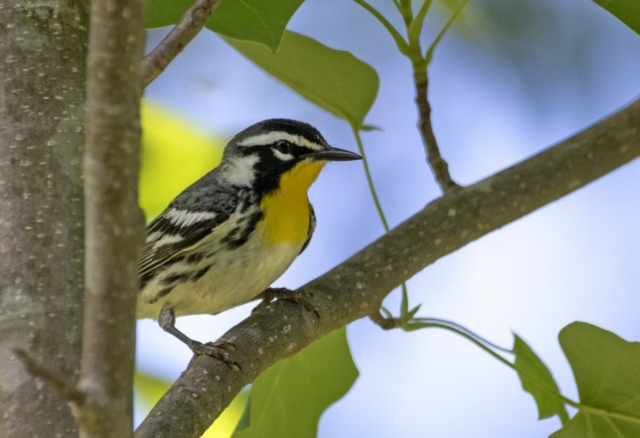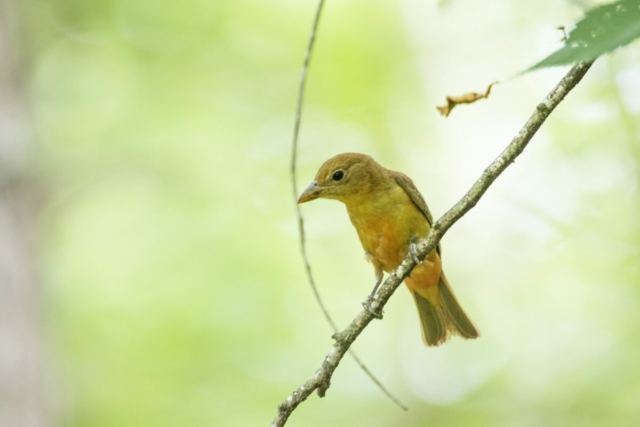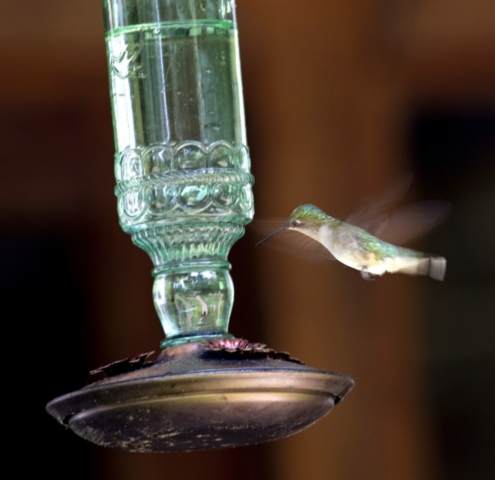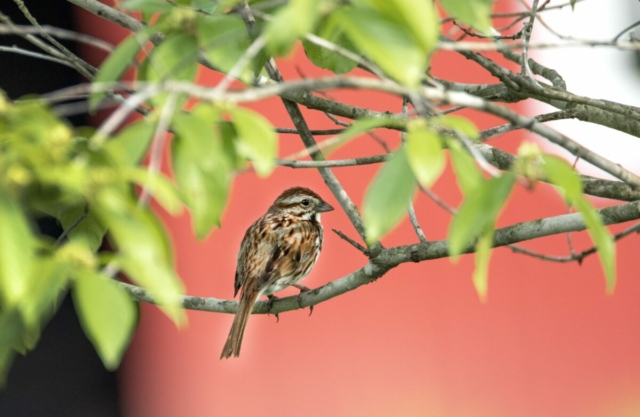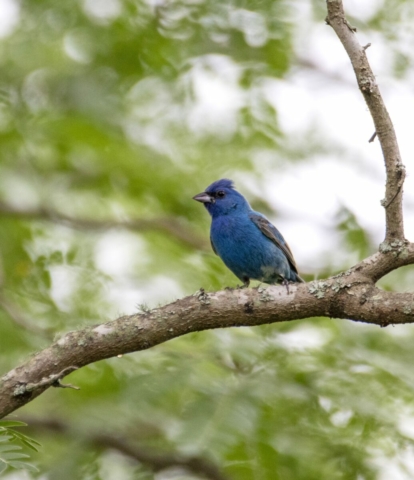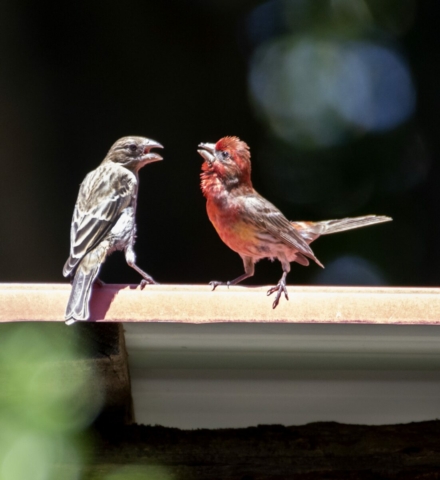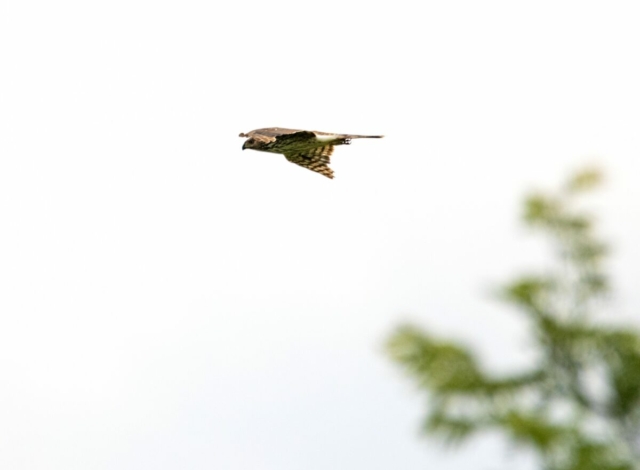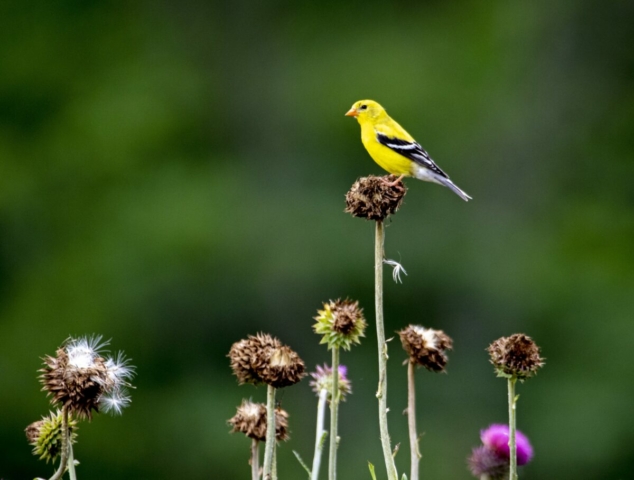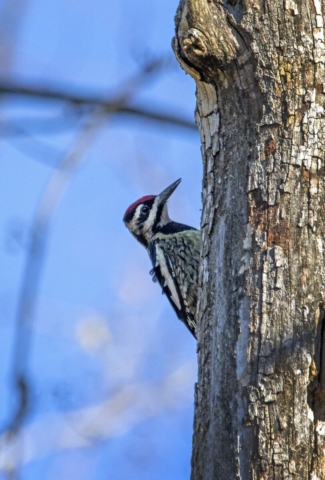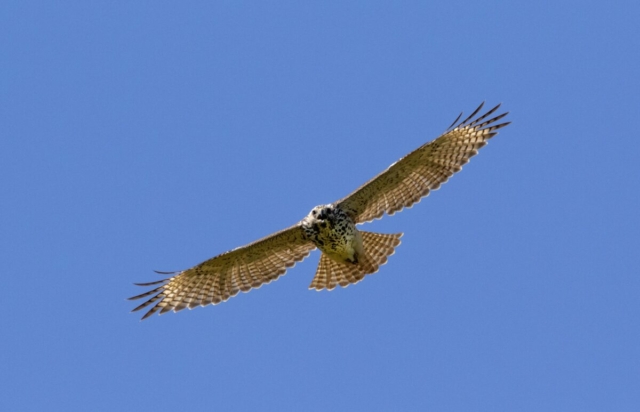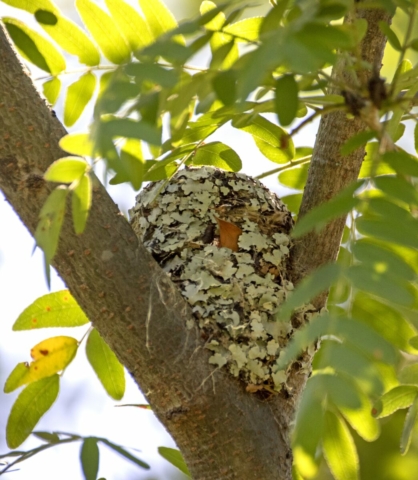Over the course of 2022, talented photographer and bird enthusiast Nathan Collie identified and photographed the birds of Old Town. Through tracking migration patterns in the spring and fall, Nathan researched and developed a list of species that he hoped to capture at the farm. By the end of 2022, Nathan was able to photograph over 65 individual species of birds on the Old Town property.
Since childhood, Nathan Collie has been profoundly influenced by the beauty of nature and the behavior of the natural world. As it became a personal sanctuary for him, he began to turn his attention to the camera to document those observations with a deeper appreciation. With both parents in the creative world of music and art, he has now become the fourth generation photographer in his family.
His subject matter reflects the landscape and wildlife, with birds in particular, of Middle Tennessee, the American West and the Gulf of Mexico. He prints with Japanese papers to create an organic two-dimensional surface and give texture to the image. Through his films and photography, Nathan shares the universal relationship that threads our human spirit to that of all creatures great and small. His nature films include all four seasons put with music, as well as films produced for Radnor Lake State Park, and Edwin Warner Parks. He contributes his talents and efforts to many non-profits with the mission for land and wildlife conservation.
Scroll down to see an alphabetical list of the birds at Old Town, and click on each bird to learn more. All photographs were taken by Nathan Collie on location at Old Town.
Image Gallery
Below is a small sampling of the more than 65 birds Nathan identified and photographed. Hover over each image to identify the bird and click to enlarge.
Birds of Old Town – in alphabetical order
Click on the name of each bird to learn more and see Nathan’s photographs
- American Crow (Common Crow) –
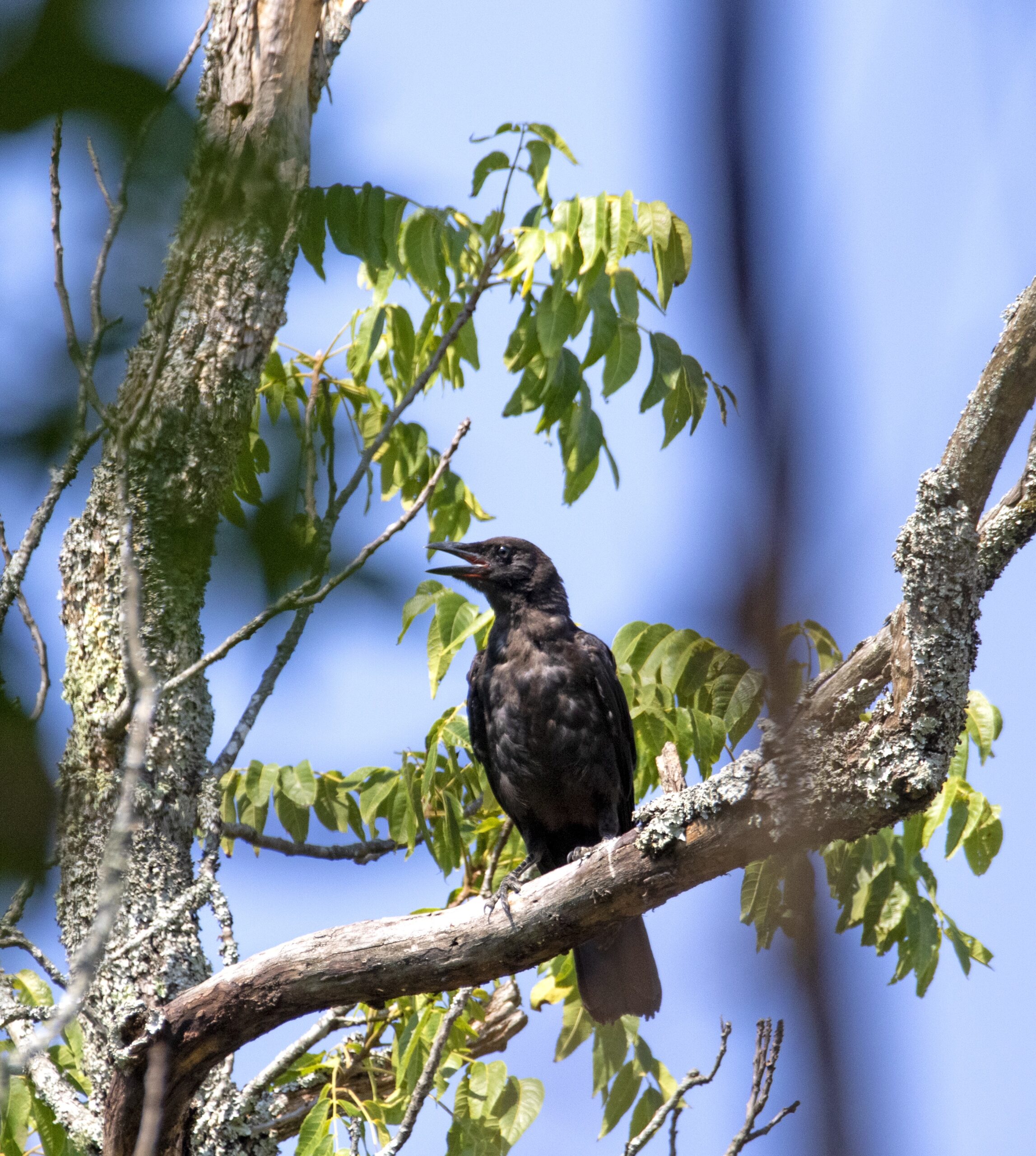
- Crows are thought to be among our most intelligent birds, and the success of the American Crow in adapting to civilization would seem to confirm this. Despite past attempts to exterminate them, crows are more common than ever in farmlands, towns, and even cities, and their distinctive caw! is a familiar sound over much of the continent. Sociable, especially when not nesting, crows may gather in communal roosts on winter nights, sometimes with thousands or even tens of thousands roosting in one grove.
- American Goldfinch –
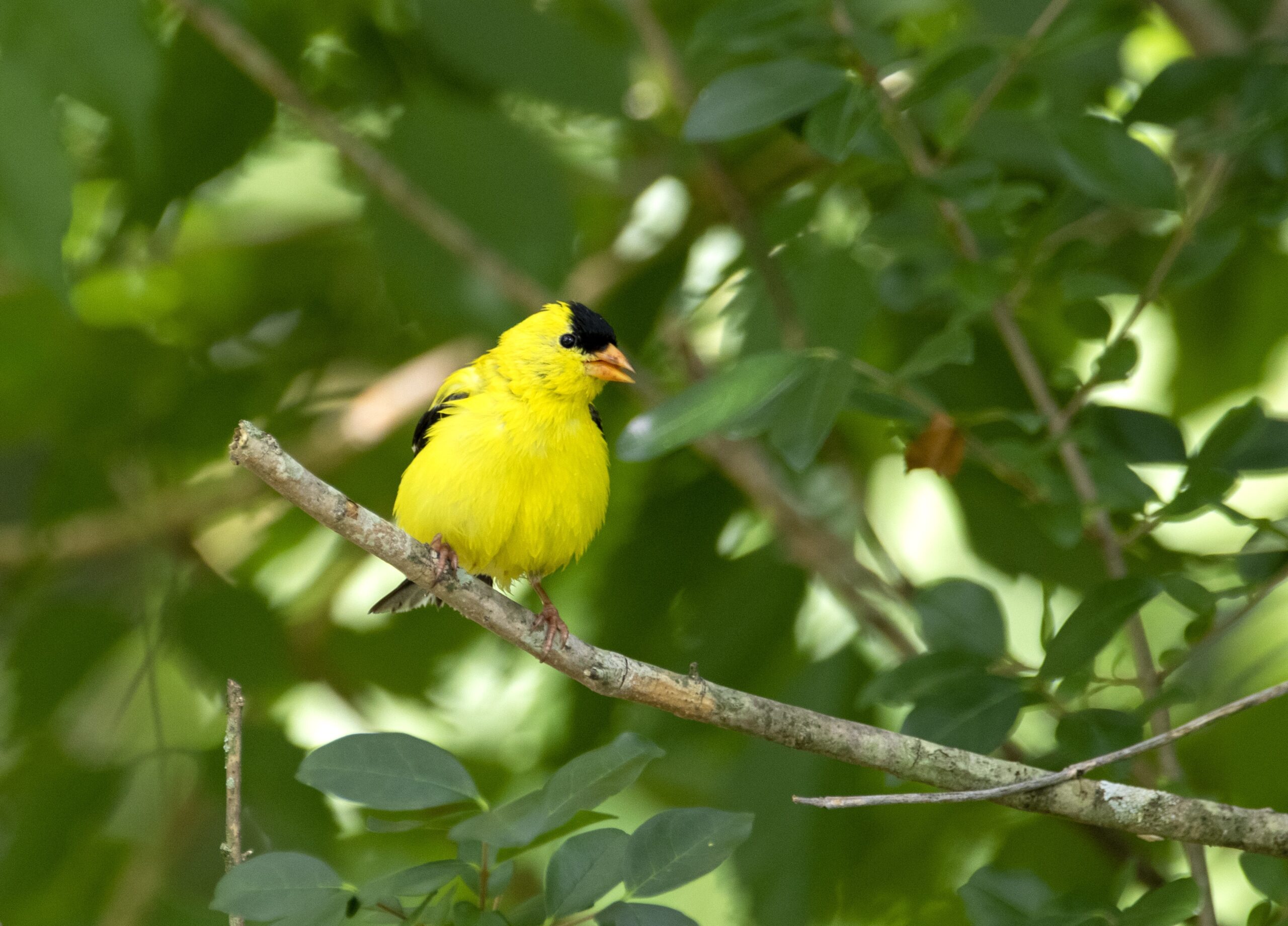
- A typical summer sight is a male American Goldfinch flying over a meadow, flashing golden in the sun, calling perchickory as it bounds up and down in flight. In winter, when males and females alike are colored in subtler brown, flocks of goldfinches congregate in weedy fields and at feeders, making musical and plaintive calls. In most regions this is a late nester, beginning to nest in mid-summer, perhaps to assure a peak supply of late-summer seeds for feeding its young.
- American Robin –
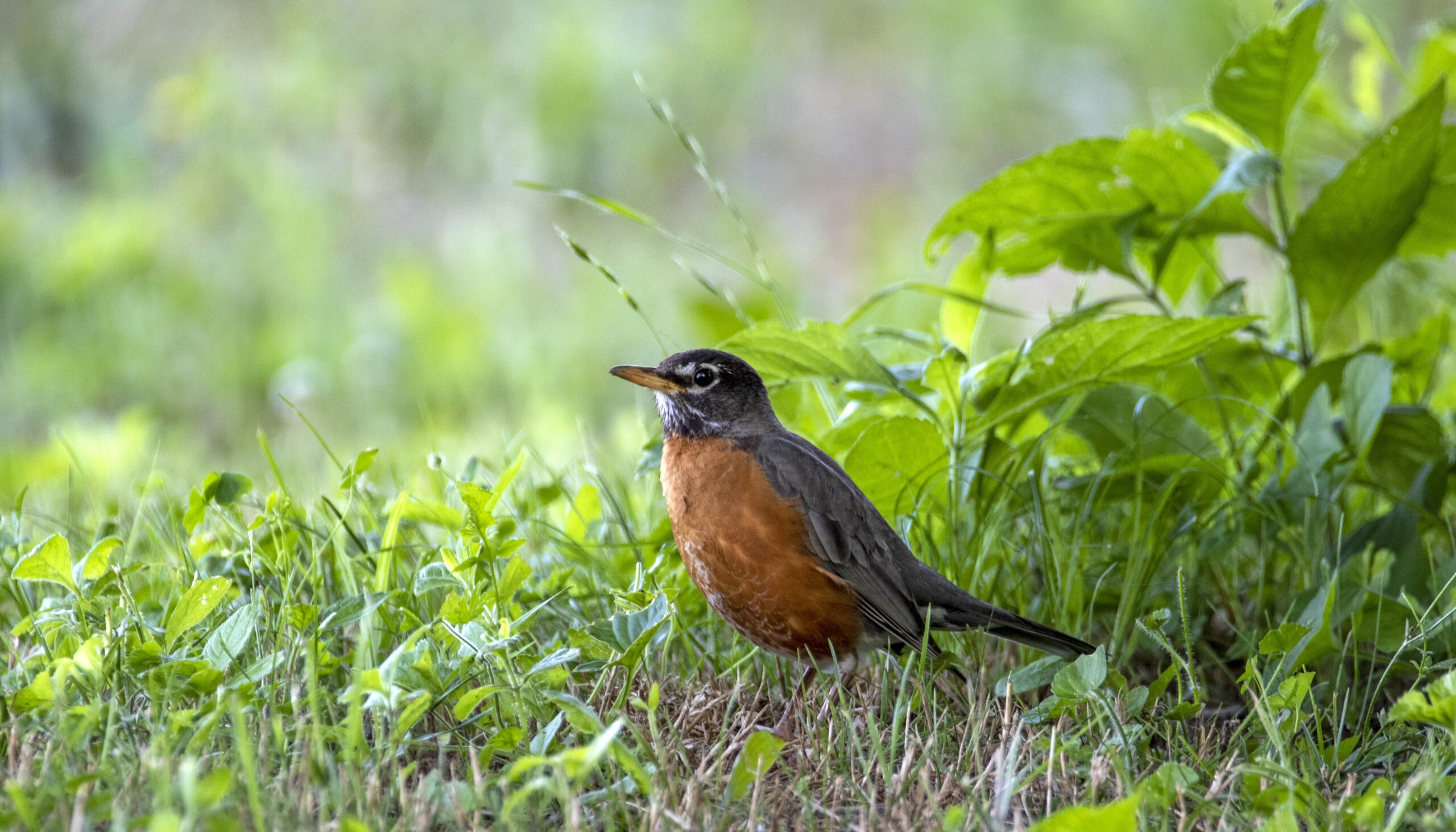
- A very familiar bird over most of North America, running and hopping on lawns with upright stance, often nesting on porches and windowsills. The Robin’s rich caroling is among the earliest bird songs heard at dawn in spring and summer, often beginning just before first light. In fall and winter, robins may gather by the hundreds in roaming flocks, concentrating at sources of food.
- Barn Swallow –

- One of our most familiar birds in rural areas and semi-open country, this swallow is often seen skimming low over fields with a flowing, graceful flight. It seems to have adopted humans as neighbors, typically placing its nest in barns or garages, or under bridges or wharves; indeed, it is now rare to find a Barn Swallow nest in a site that is not manmade. The species is also common across Europe and Asia, wintering to southern Africa and South America.
- Barred Owl –
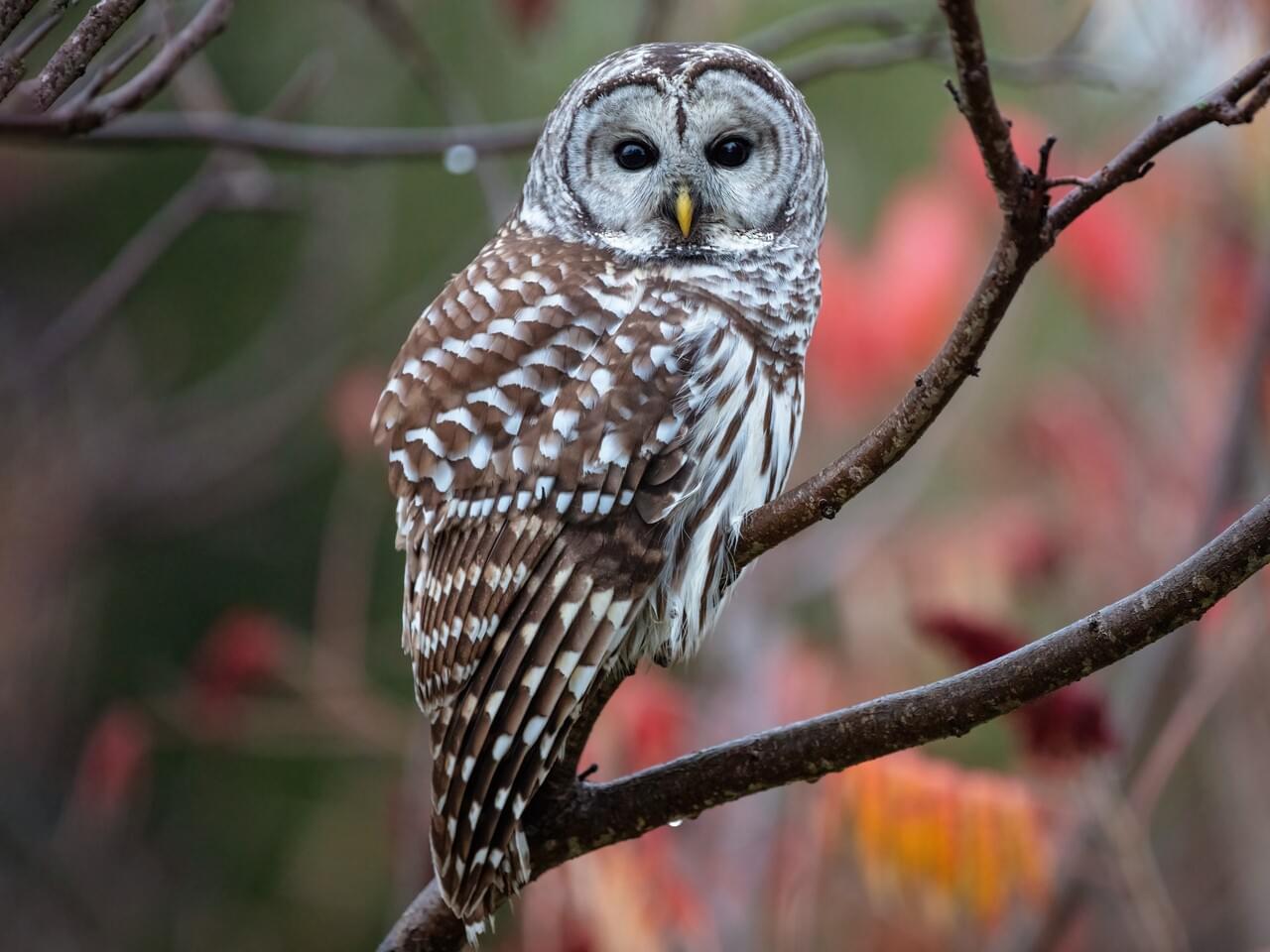
- The rich baritone hooting of the Barred Owl is a characteristic sound in southern swamps, where members of a pair often will call back and forth to each other. Although the bird is mostly active at night, it will also call and even hunt in the daytime. Only a little smaller than the Great Horned Owl, the Barred Owl is markedly less aggressive, and competition with its tough cousin may keep the Barred out of more open woods.
- Belted Kingfisher –

- The Belted Kingfisher is often first noticed by its wild rattling call as it flies over rivers or lakes. It may be seen perched on a high snag, or hovering on rapidly beating wings, then plunging headfirst into the water to grab a fish. Found almost throughout North America at one season or another, it is the only member of its family to be seen in most areas north of Mexico.
- Black-and-white Warbler –
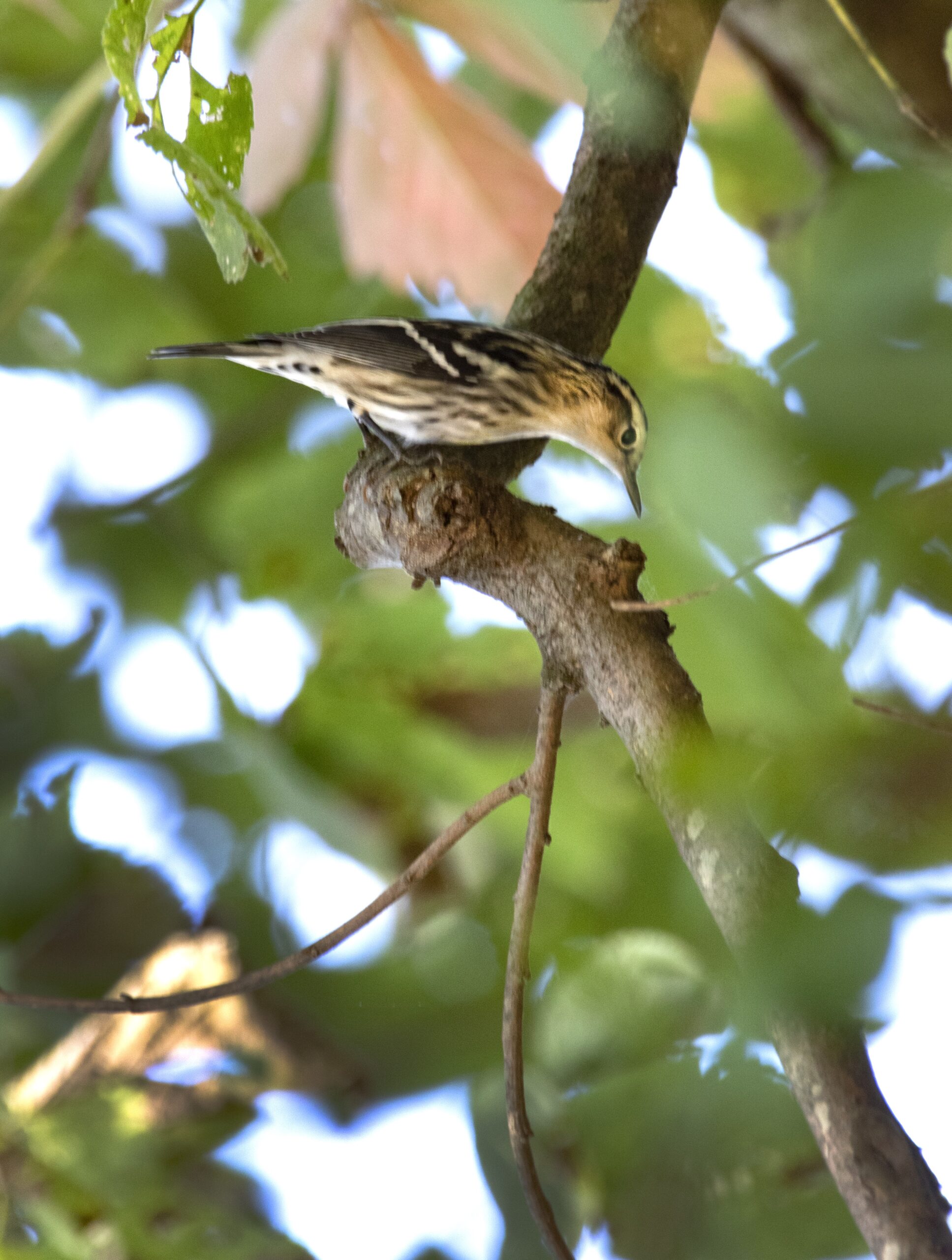
- This bird is often a favorite warbler for beginning birders, because it is easy to see and easy to recognize. It was once known as the ‘Black-and-white Creeper,’ a name that describes its behavior quite well. Like a nuthatch or creeper (and unlike other warblers), it climbs about on the trunks and major limbs of trees, seeking insects in the bark crevices. It often feeds low, and nests even lower, usually on the ground.
- Black-throated Green Warbler –
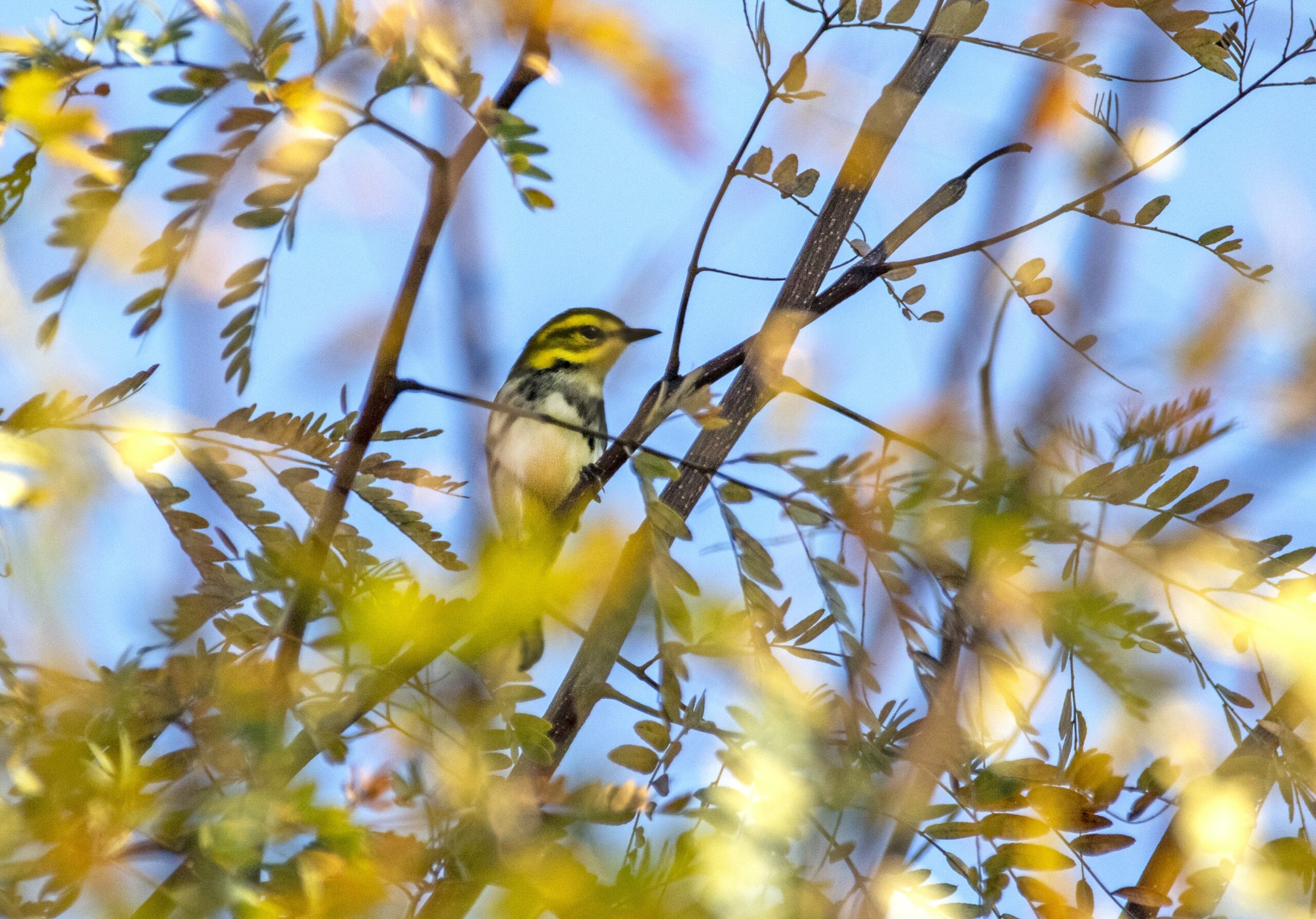
- In the east, some of the easiest warbler voices to recognize are the patterned songs of the Black-throated Green. As if to confirm the identification, the brilliantly colored male often perches out in the open to sing, perhaps on a high twig of a spruce. He actually has two song types, used in different situations: he sings zoo zee zoo zoo zee to proclaim and defend his nesting territory, and zee zee zee zoo zee in courtship or when communicating with his mate.
- Blue Jay –
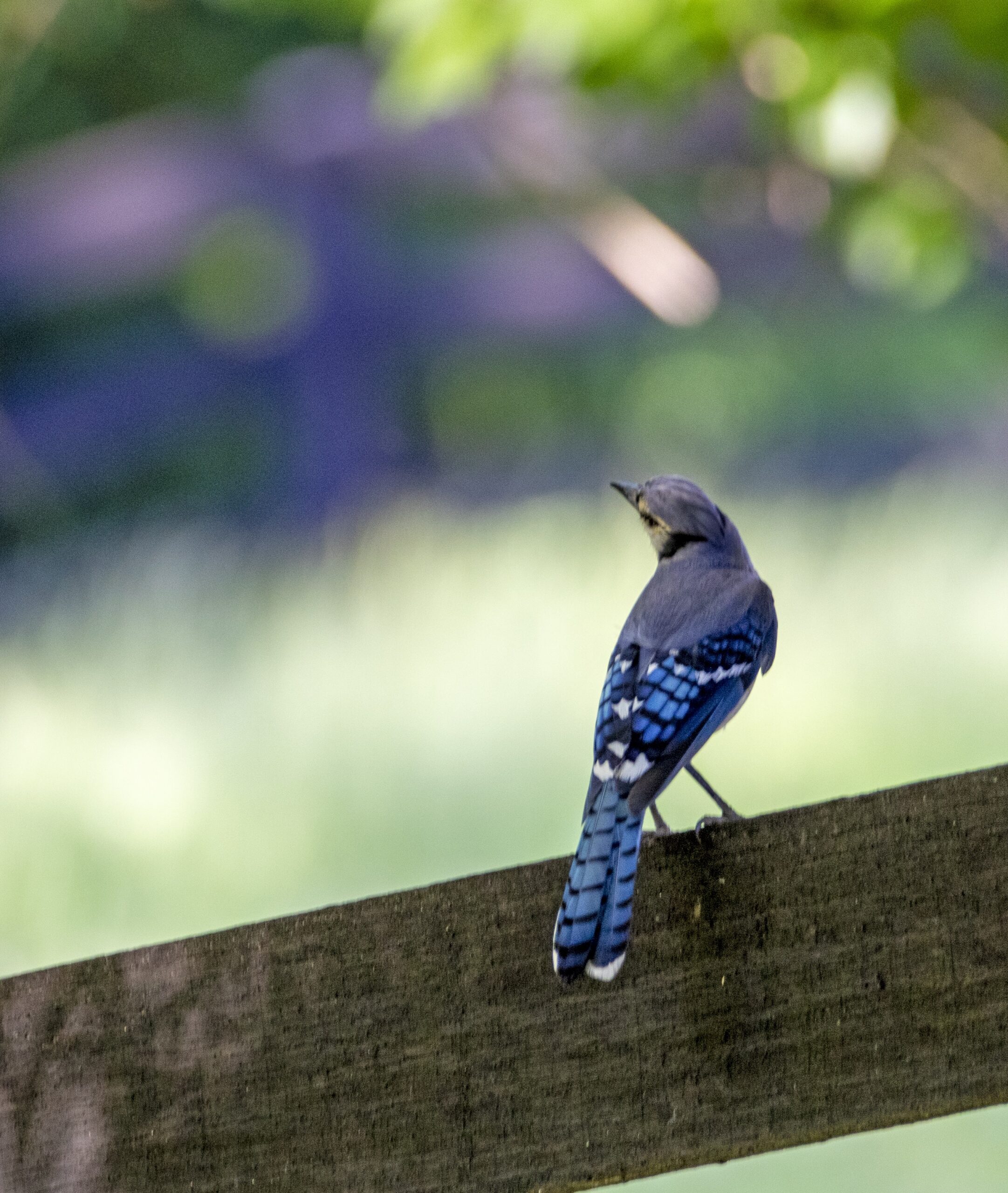
- One of the loudest and most colorful birds of eastern back yards and woodlots, the Blue Jay is unmistakable. Intelligent and adaptable, it may feed on almost anything, and it is quick to take advantage of bird feeders. Besides their raucous jay! jay! calls, Blue Jays make a variety of musical sounds, and they can do a remarkable imitation of the scream of a Red-shouldered Hawk. Not always conspicuous, they slip furtively through the trees when tending their own nest or going to rob the nest of another bird.
- Blue-gray Gnatcatcher –
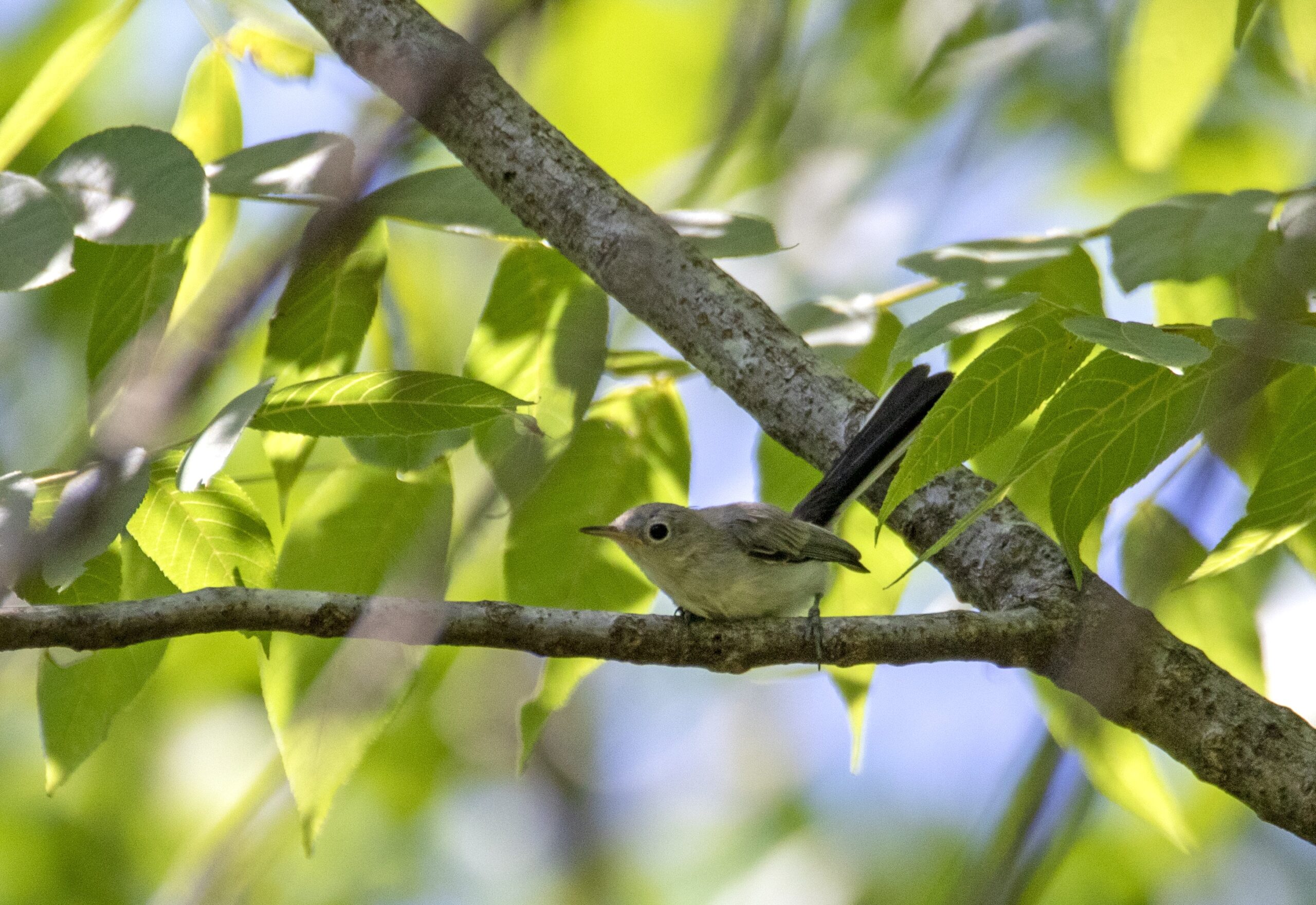
- A very small woodland bird with a long tail, usually seen flitting about in the treetops, giving a short whining callnote. Often it darts out in a short, quick flight to snap up a tiny insect in mid-air. Widespread in summer, its breeding range is still expanding toward the north.
- Brown-headed Cowbird –
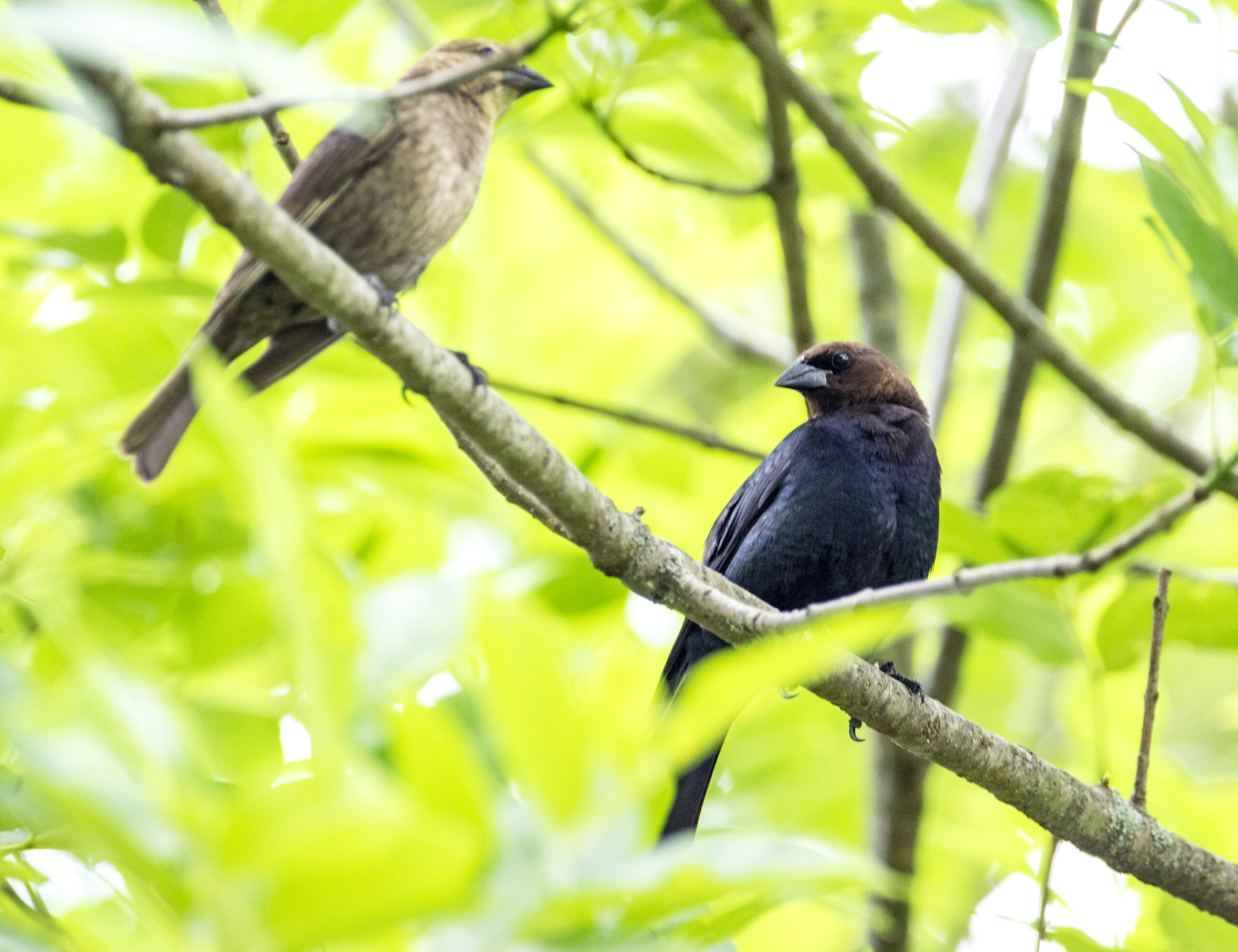
- Centuries ago this bird probably followed bison herds on the Great Plains, feeding on insects flushed from the grass by the grazers. Today it follows cattle, and occurs abundantly from coast to coast. Its spread has represented bad news for other songbirds: Cowbirds lay their eggs in nests of other birds. Heavy parasitism by cowbirds has pushed some species to the status of ‘endangered’ and has probably hurt populations of some others.
- Brown Thrasher –
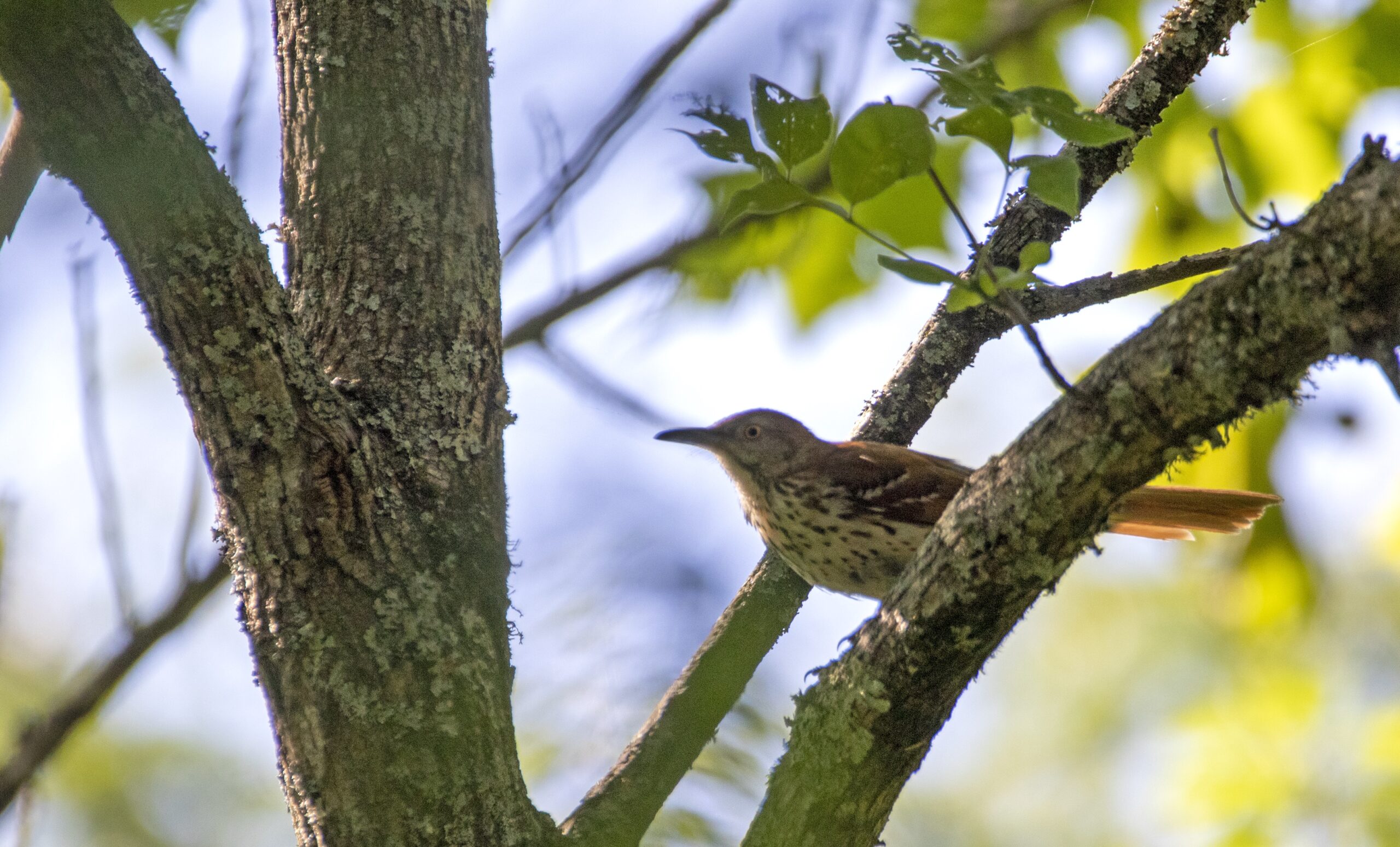
- The big, foxy-red Brown Thrasher is a familiar bird over much of the east. Sometimes it forages boldly on open lawns; more often it scoots into dense cover at any disturbance, hiding among the briar tangles and making loud crackling callnotes. Although the species spends most of its time close to the ground, the male Brown Thrasher sometimes will deliver its rich, melodious song of doubled phrases from the top of a tall tree.
- Cardinal –
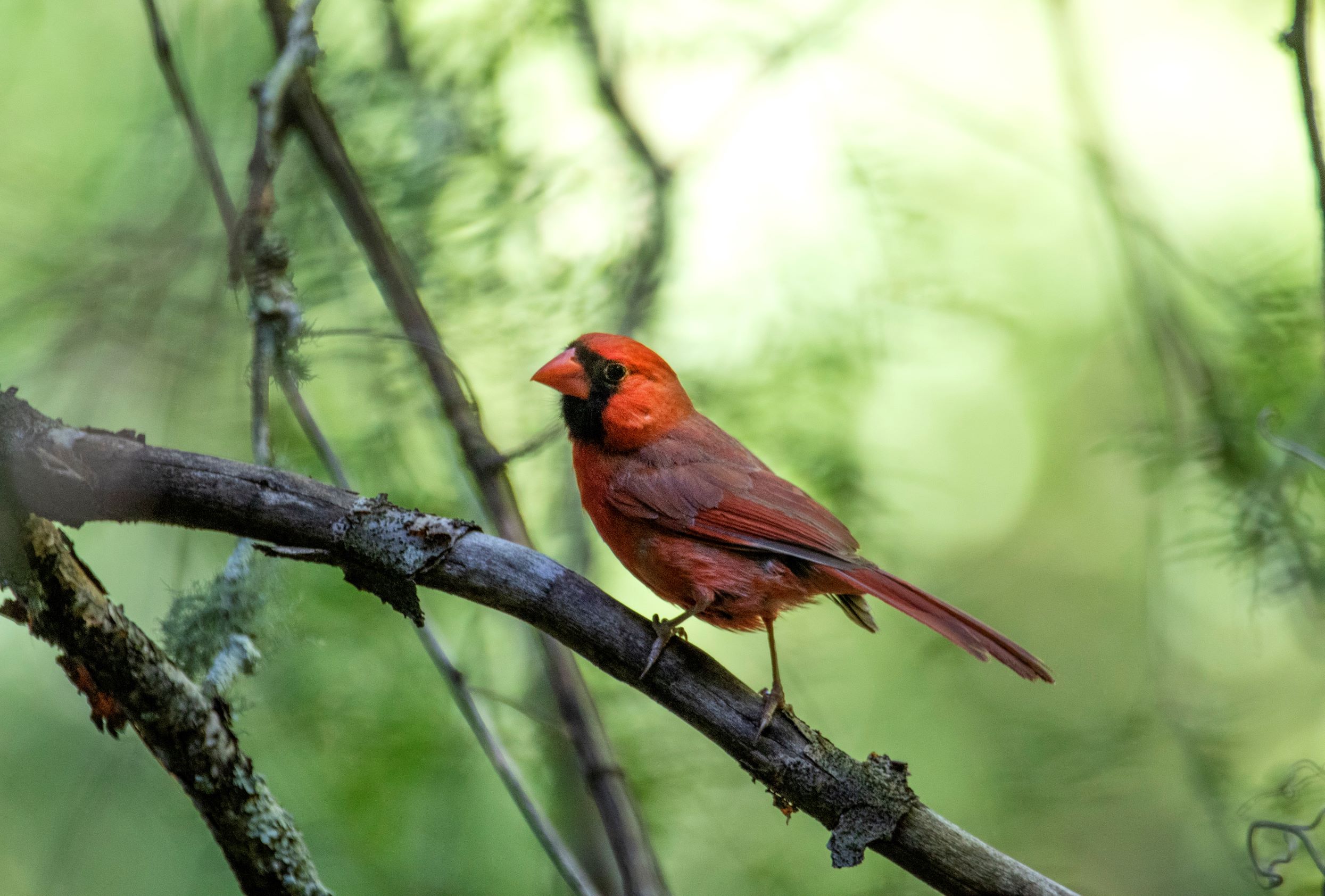
- One of our most popular birds, the Cardinal is the official state bird of no fewer than seven eastern states. Abundant in the Southeast, it has been extending its range northward for decades, and it now brightens winter days with its color and its whistled song as far north as southeastern Canada. Feeders stocked with sunflower seeds may have aided its northward spread. West of the Great Plains, the Cardinal is mostly absent, but it is locally common in the desert Southwest.
- Carolina Chickadee –
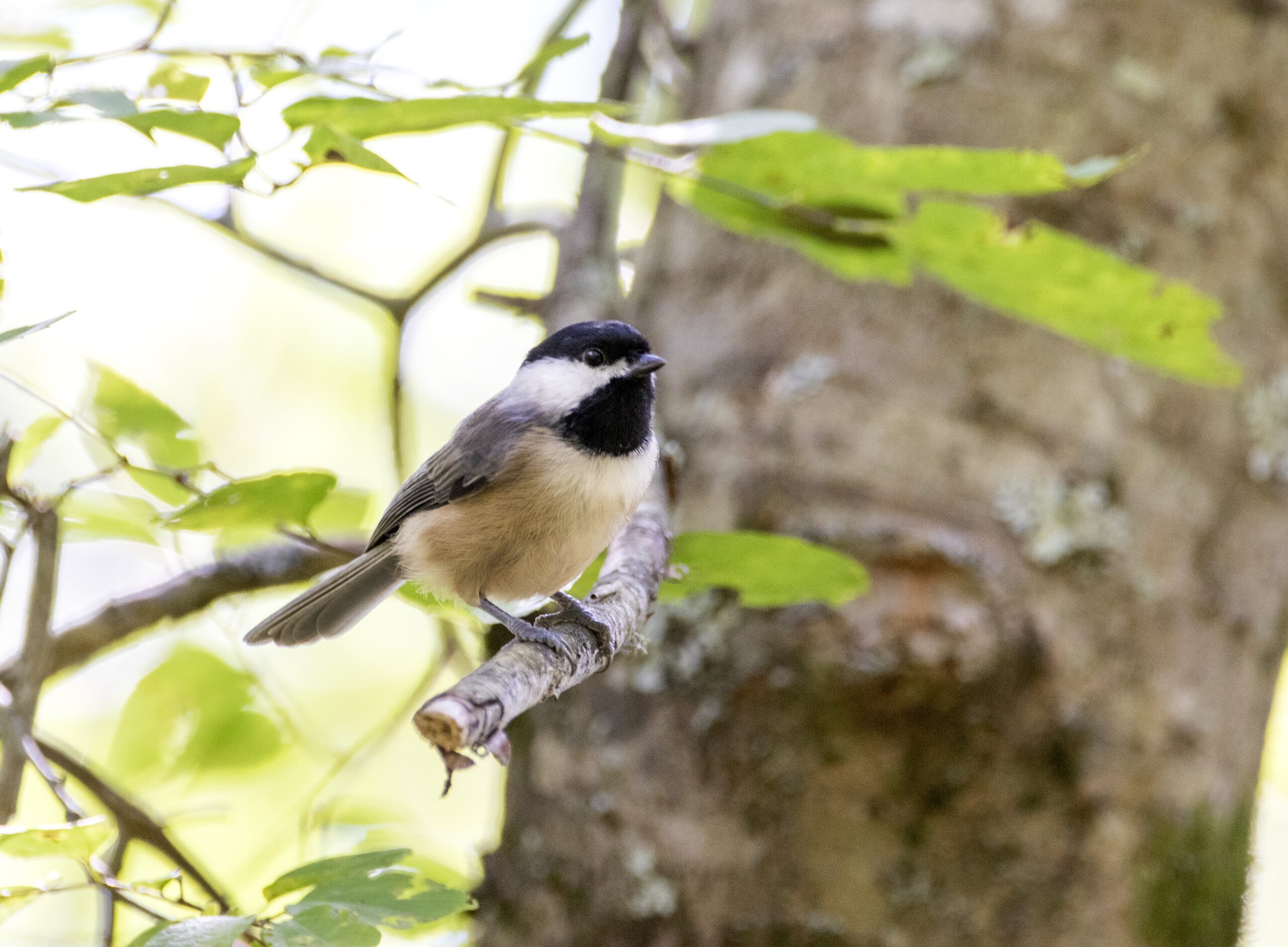
- Very similar to the Black-capped Chickadee, this bird replaces it in the southeastern states. Living in milder climates, it has been reported to be less of a visitor to bird feeders, but it does come into suburban yards for sunflower seeds. Where the ranges of Black-capped and Carolina chickadees come together, they often interbreed. In these contact zones, they also can learn to imitate each other’s songs — causing great confusion for birdwatchers.
- Carolina Wren –
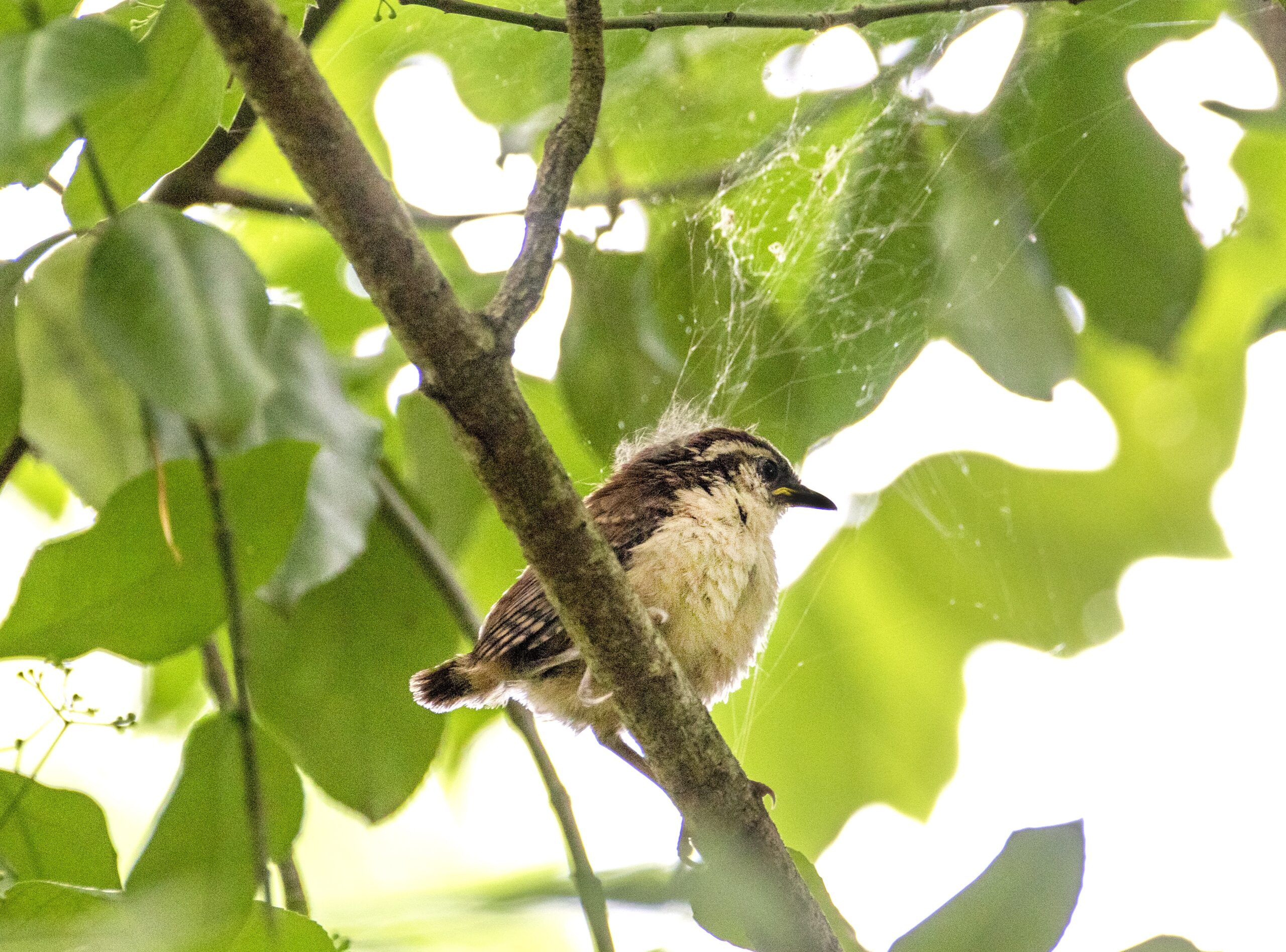
- More brightly colored than most wrens, and with a rich musical song, Carolina Wrens are common in open woods and backyards in the southeast. There they busily explore brushpiles and low tangles. The adults live in pairs all year, and they may ‘duet’ at any season, with the female giving a chattering note while the male sings. The northern edge of this species’ range varies over time: it gradually expands northward during series of mild years, then gets knocked southward again by very severe winters.
- Cedar Waxwing –
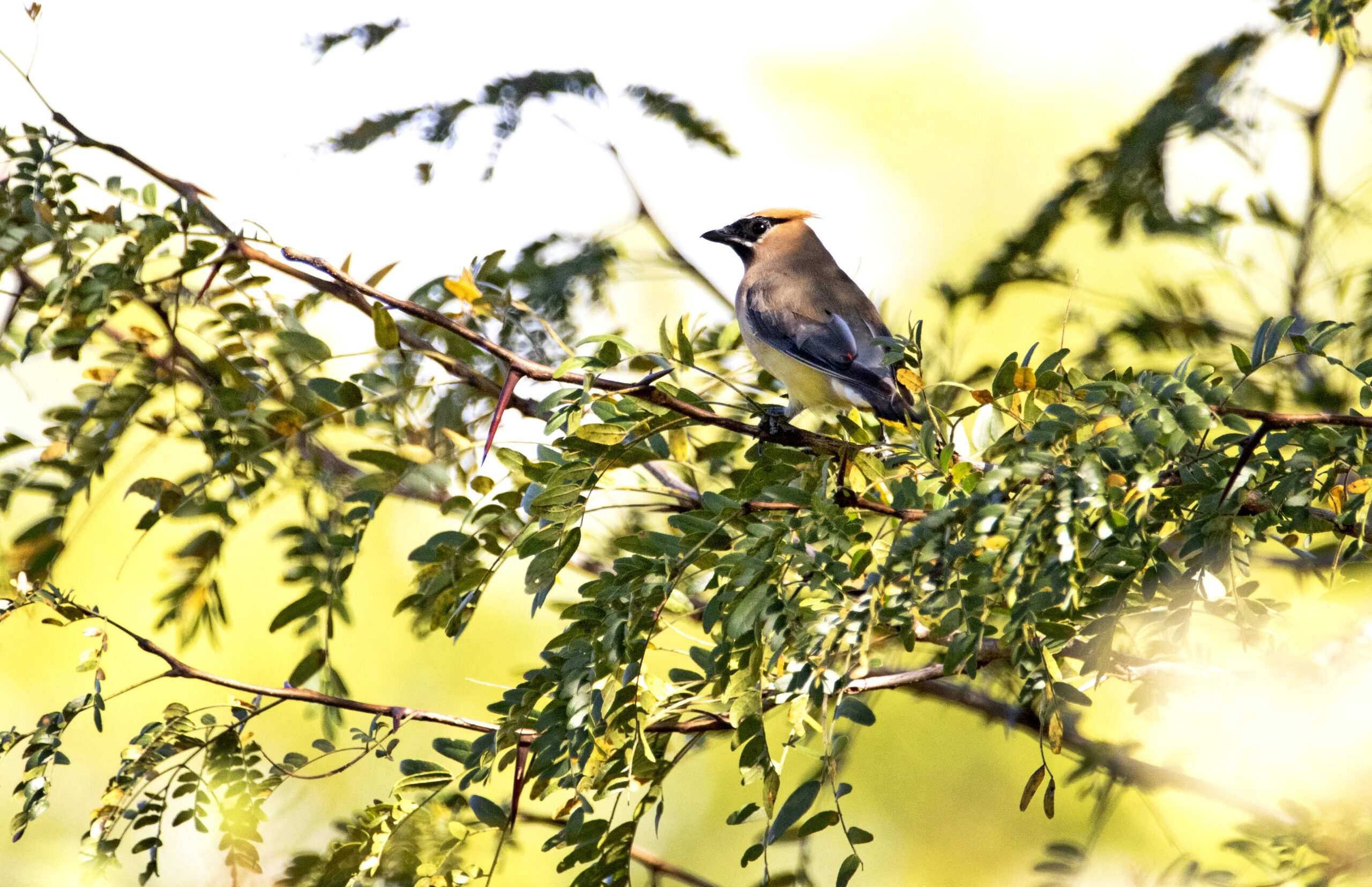
- With thin, lisping cries, flocks of Cedar Waxwings descend on berry-laden trees and hedges, to flutter among the branches as they feast. These birds are sociable at all seasons, and it is rare to see just one waxwing. Occasionally a line of waxwings perched on a branch will pass a berry back and forth, from bill to bill, until one of them swallows it. This species has a more southerly range than the Bohemian Waxwing, and is a familiar visitor to most parts of this continent south of the Arctic.
- Chipping Sparrow –
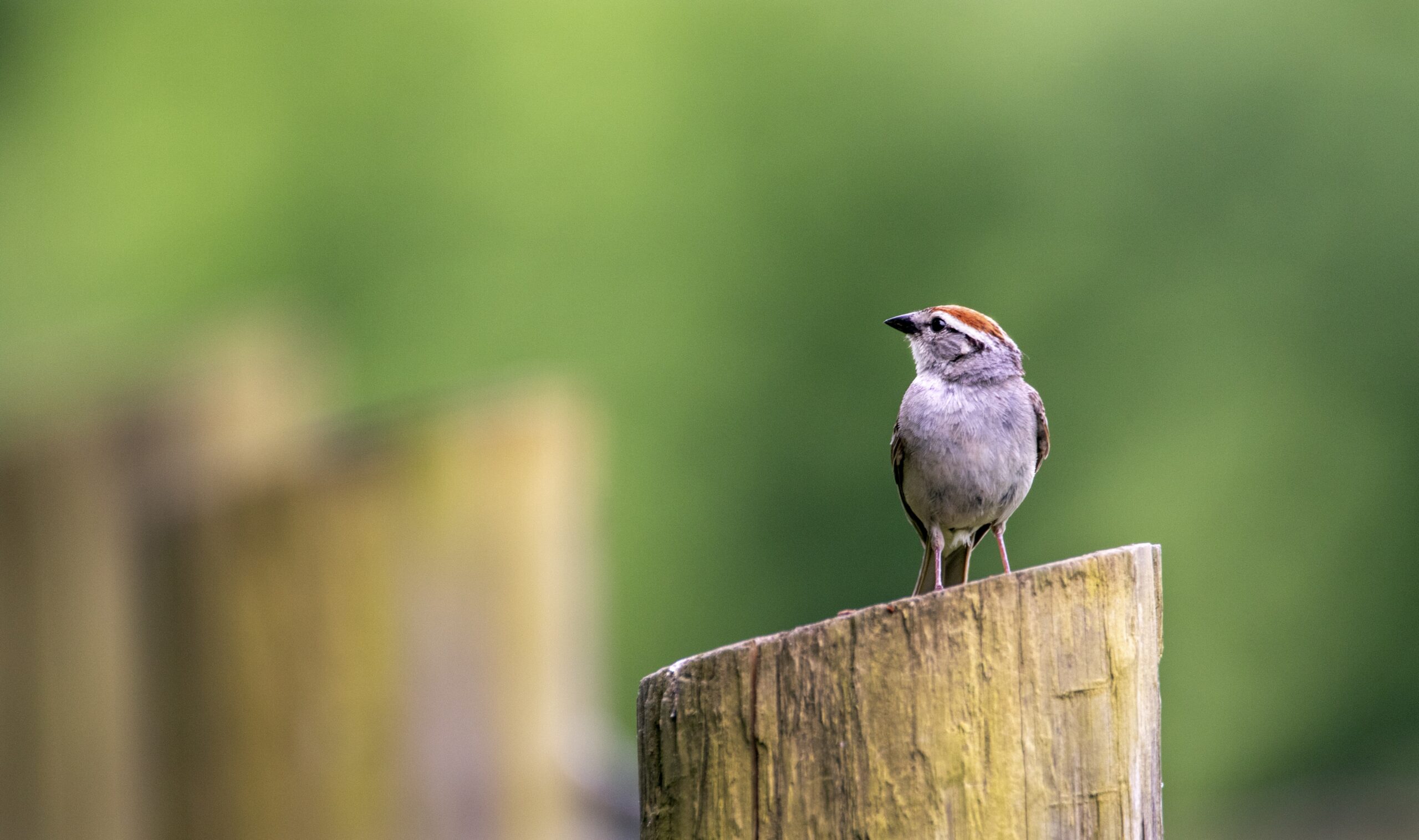
- Common over much of the continent is the little Chipping Sparrow. Originally a bird of open pine woods and edges, it has adapted well to altered landscapes. It now nests in gardens and parks in many areas, its tame behavior making it well-known and popular. Evidently it was even more common in towns in the 19th century; but then the House Sparrow, introduced from Europe, took over its place as our number one city ‘sparrow.’
- Common Grackle –
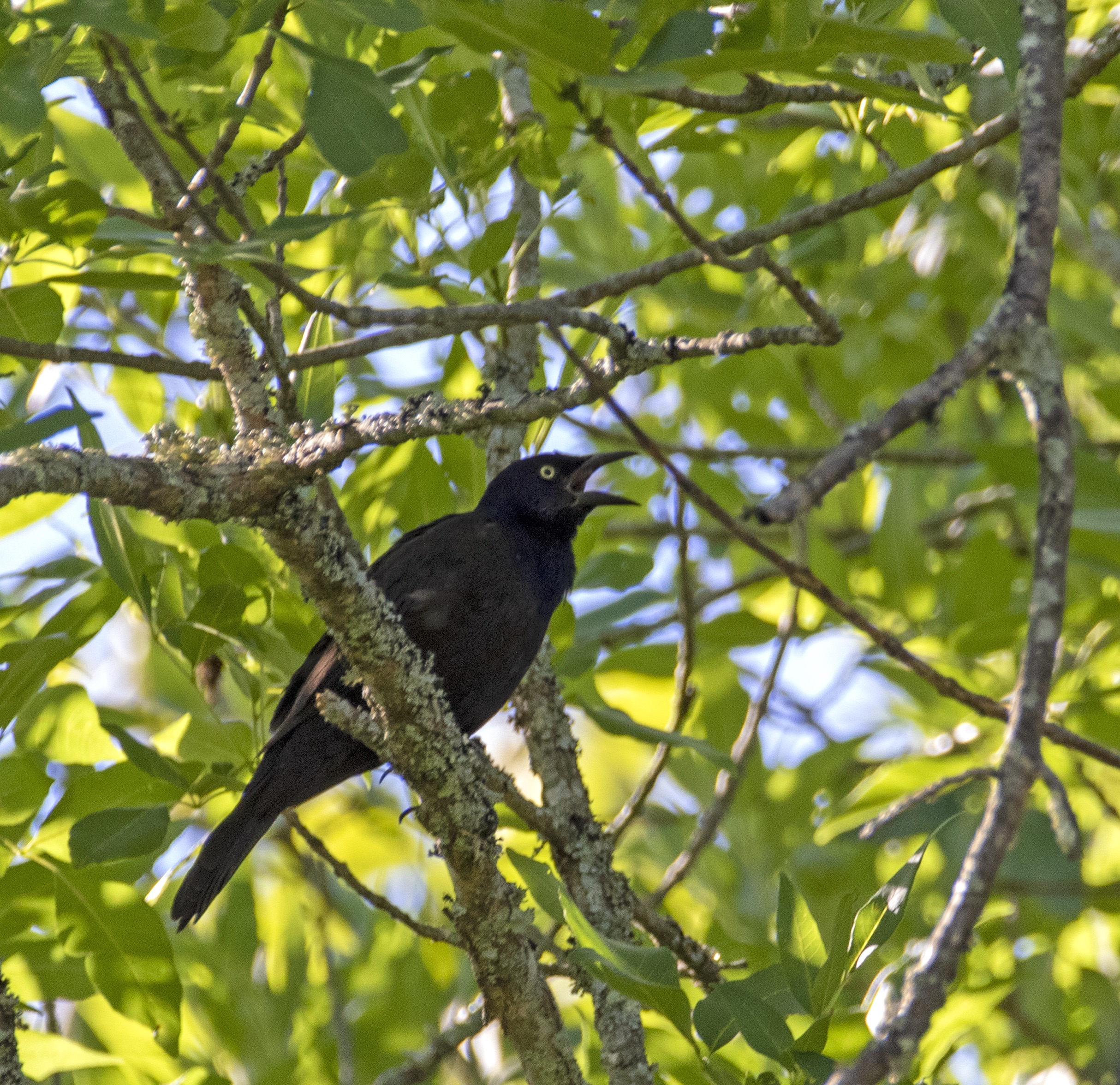
- Throughout the east and midwest, this big blackbird is a very familiar species on suburban lawns, striding about with deliberate steps as it searches for insects. Common Grackles often nest in small colonies, and several males may perch in adjacent treetops to sing their creaking, grating songs. Big flocks are often seen flying overhead in the evening, heading for major communal roosts, especially from late summer through winter.
- Common Yellowthroat –
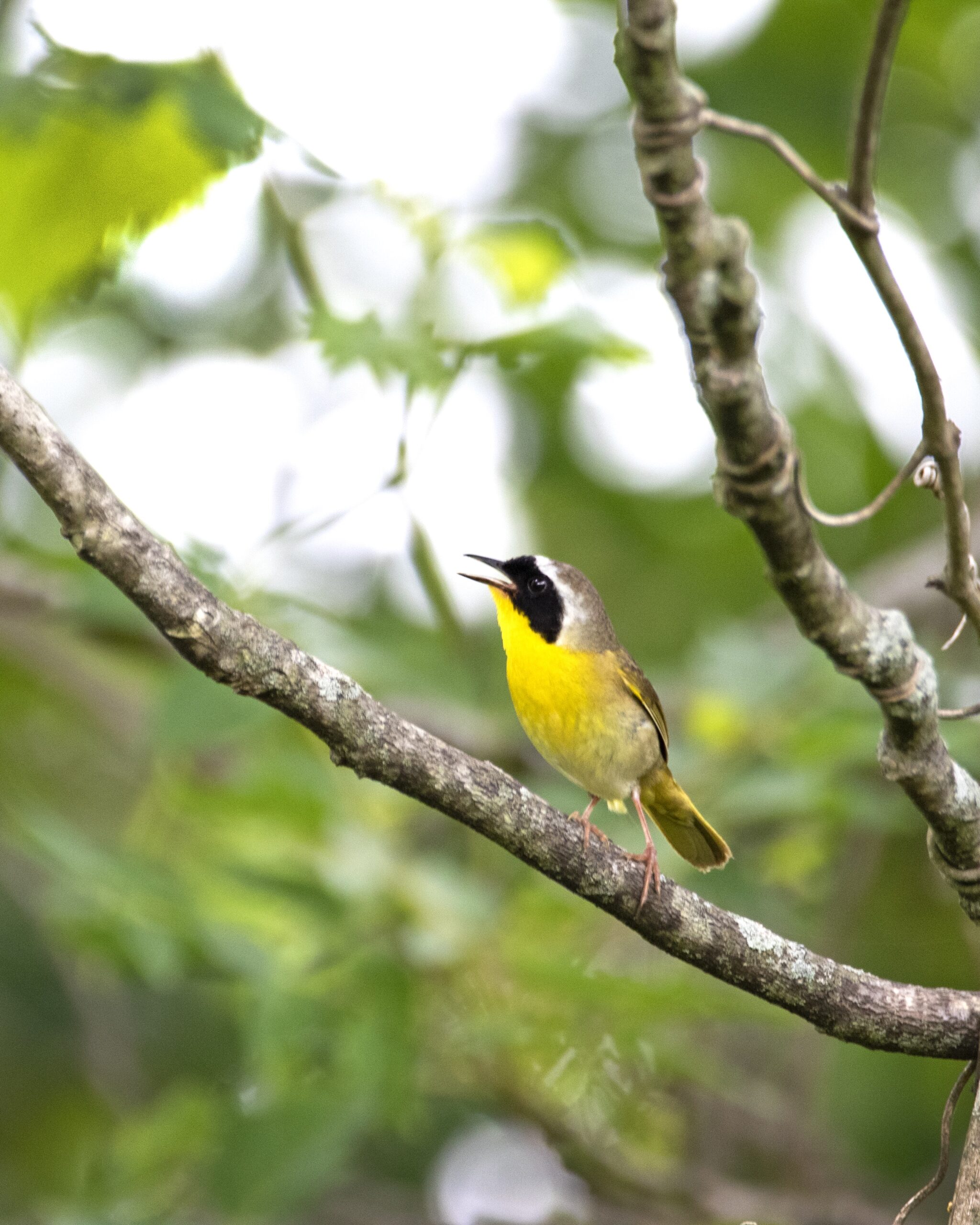
- Abundant and well-known, the Common Yellowthroat has succeeded by being a nonconformist. As the only one of our warblers that will nest in open marshes, it is found in practically every reed-bed and patch of cattails from coast to coast. Although it sometimes hides in the marsh, its low rough callnote will reveal its presence. The male often perches atop a tall stalk to rap out his distinctive song, wichity-wichity-wichity.
- Cooper’s Hawk –
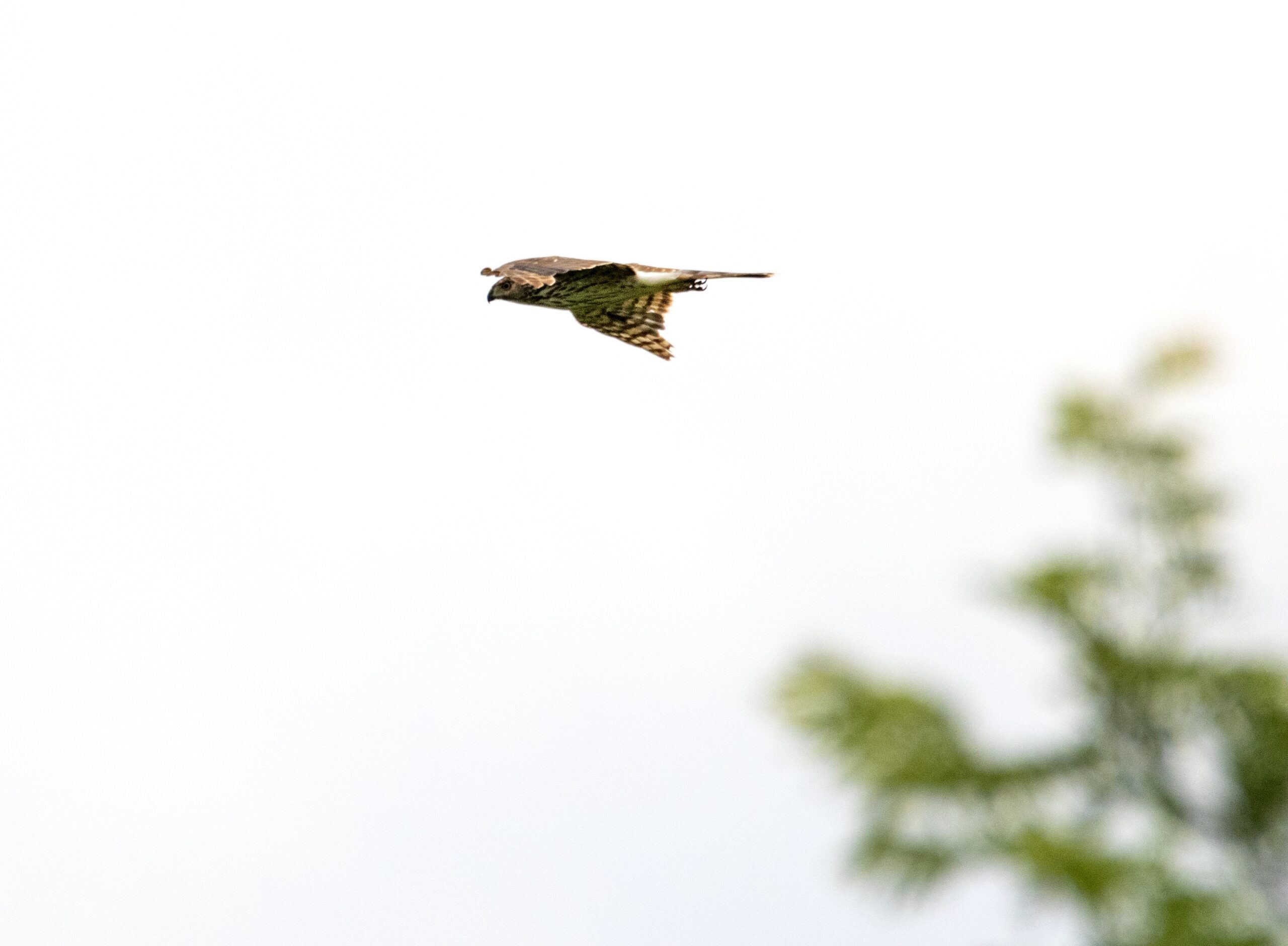
- A medium-sized hawk of the woodlands. Feeding mostly on birds and small mammals, it hunts by stealth, approaching its prey through dense cover and then pouncing with a rapid, powerful flight. Of the three bird-eating Accipiter hawks, Cooper’s is the mid-sized species and the most widespread as a nesting bird south of Canada.
- Downy Woodpecker –
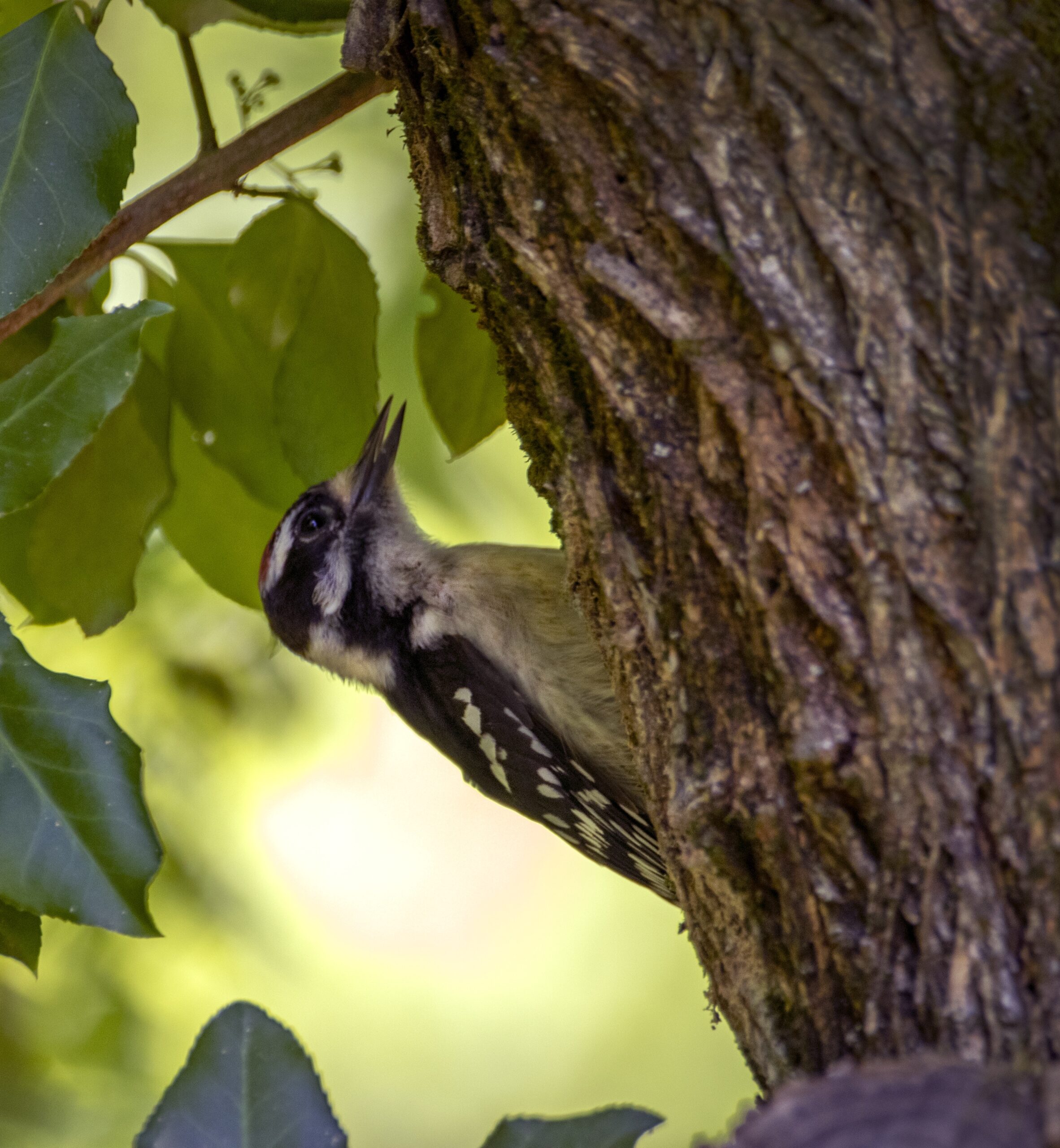
- The smallest woodpecker in North America, common and widespread, although it avoids the arid southwest. In the east this is the most familiar member of the family, readily entering towns and city parks, coming to backyard bird feeders. Its small size makes it versatile, and it may forage on weed stalks as well as in large trees. In winter it often joins roving mixed flocks of chickadees, nuthatches, and other birds in the woods.
- Eastern Bluebird –
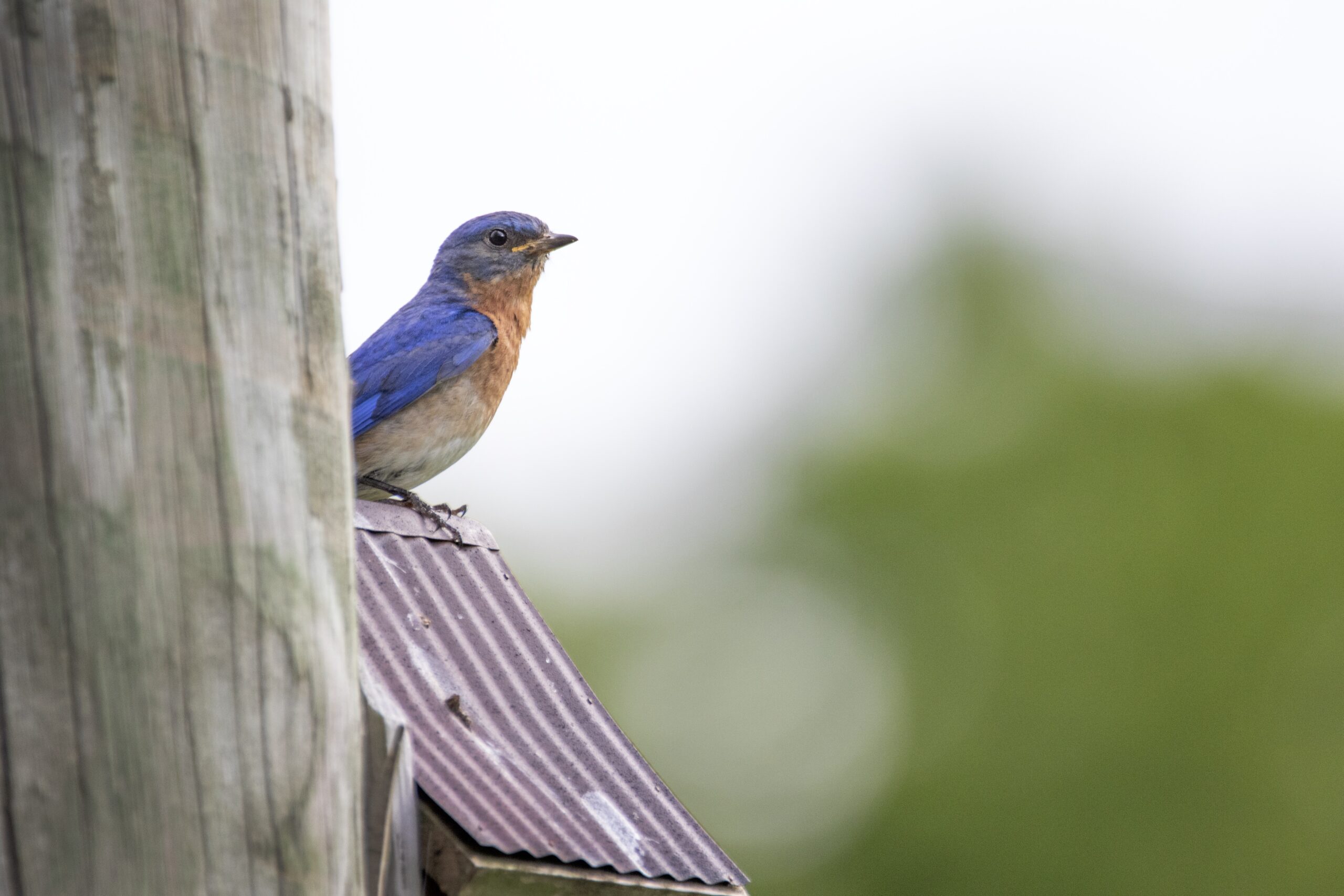
- This is the most widespread of the three bluebirds. Although it is mostly ‘eastern’ in our area, its total range extends south to Nicaragua. A high percentage of Eastern Bluebirds in North America today nest in birdhouses put up especially for them along ‘bluebird trails.’ When they are not nesting, these birds roam the countryside in small flocks.
- Eastern Pheobe –

- Despite its plain appearance, this flycatcher is often a favorite among eastern birdwatchers. It is among the earliest of migrants, bringing hope that spring is at hand. Seemingly quite tame, it often nests around buildings and bridges where it is easily observed. Best of all, its gentle tail-wagging habit and soft fee-bee song make the Phoebe easy to identify, unlike many flycatchers.
- Eastern Towhee –
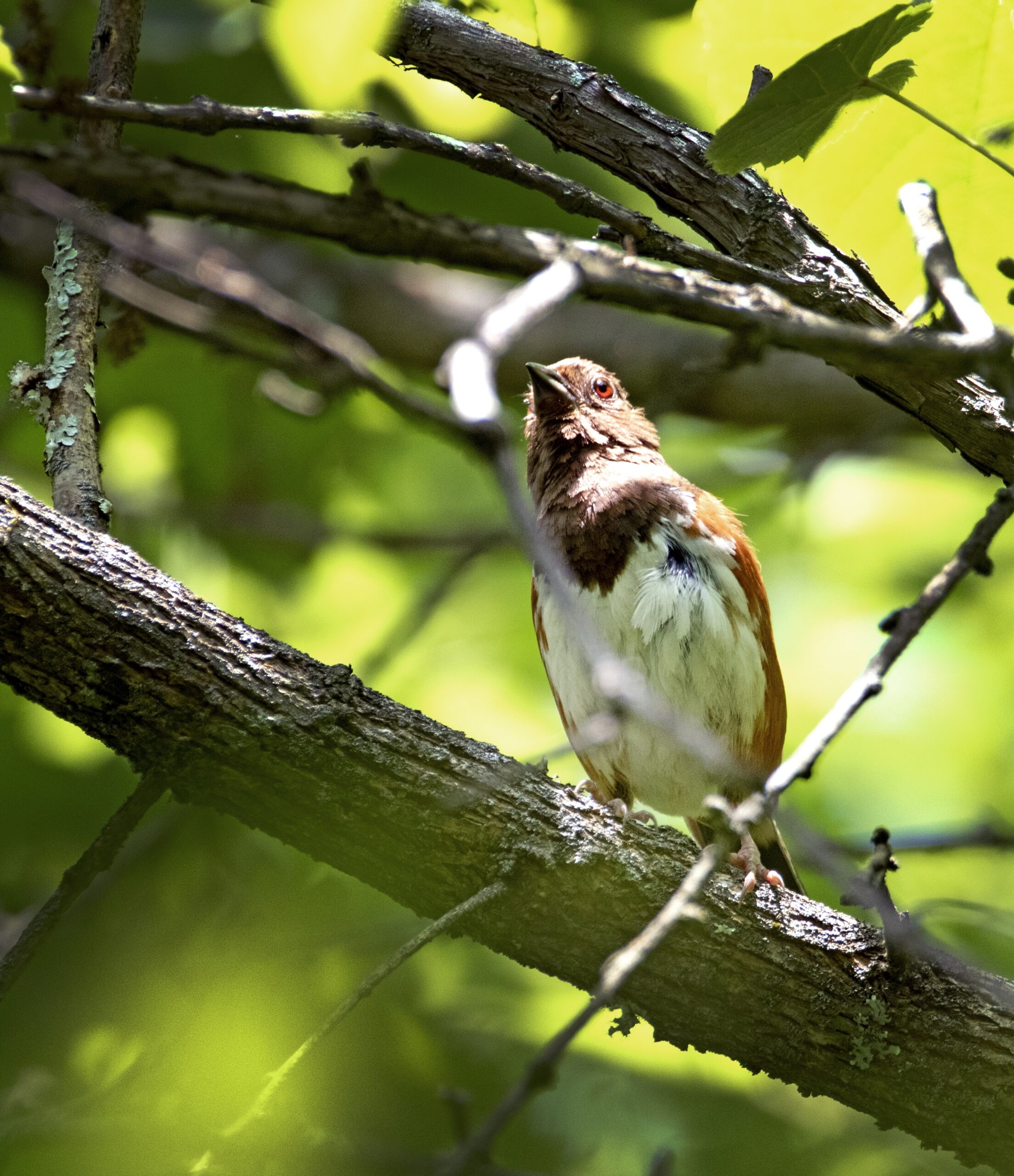
- Sometimes secretive but often common, this bird may be noticed first by the sound of industrious scratching in the leaf-litter under dense thickets. In the nesting season, males become bolder, singing from high perches. In some areas this bird is commonly known as ‘Chewink,’ after the sound of its callnote. In parts of the Southeast and Florida, the towhees have white eyes.
- Eastern Wood-Pewee –
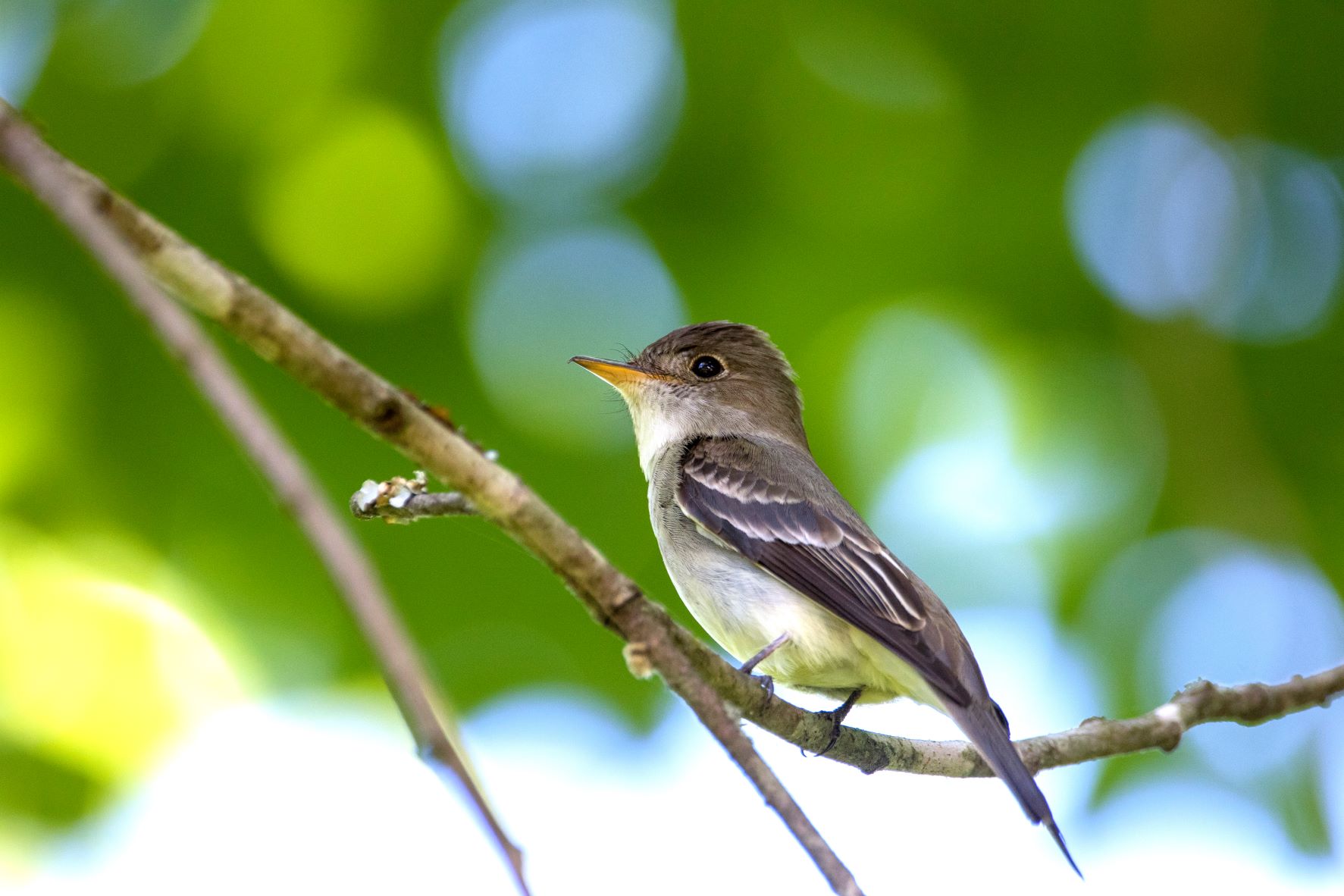
- In eastern woods in summer, the plaintive whistled pee-a-wee of this small flycatcher is often heard before the bird is seen. The bird itself is usually somewhere in the leafy middle story of the trees, perched on a bare twig, darting out to catch passing insects. The Wood-Pewee sings most often at dawn and dusk, and it may continue singing quite late in the evening, after most songbirds have fallen silent.
- Field Sparrow –
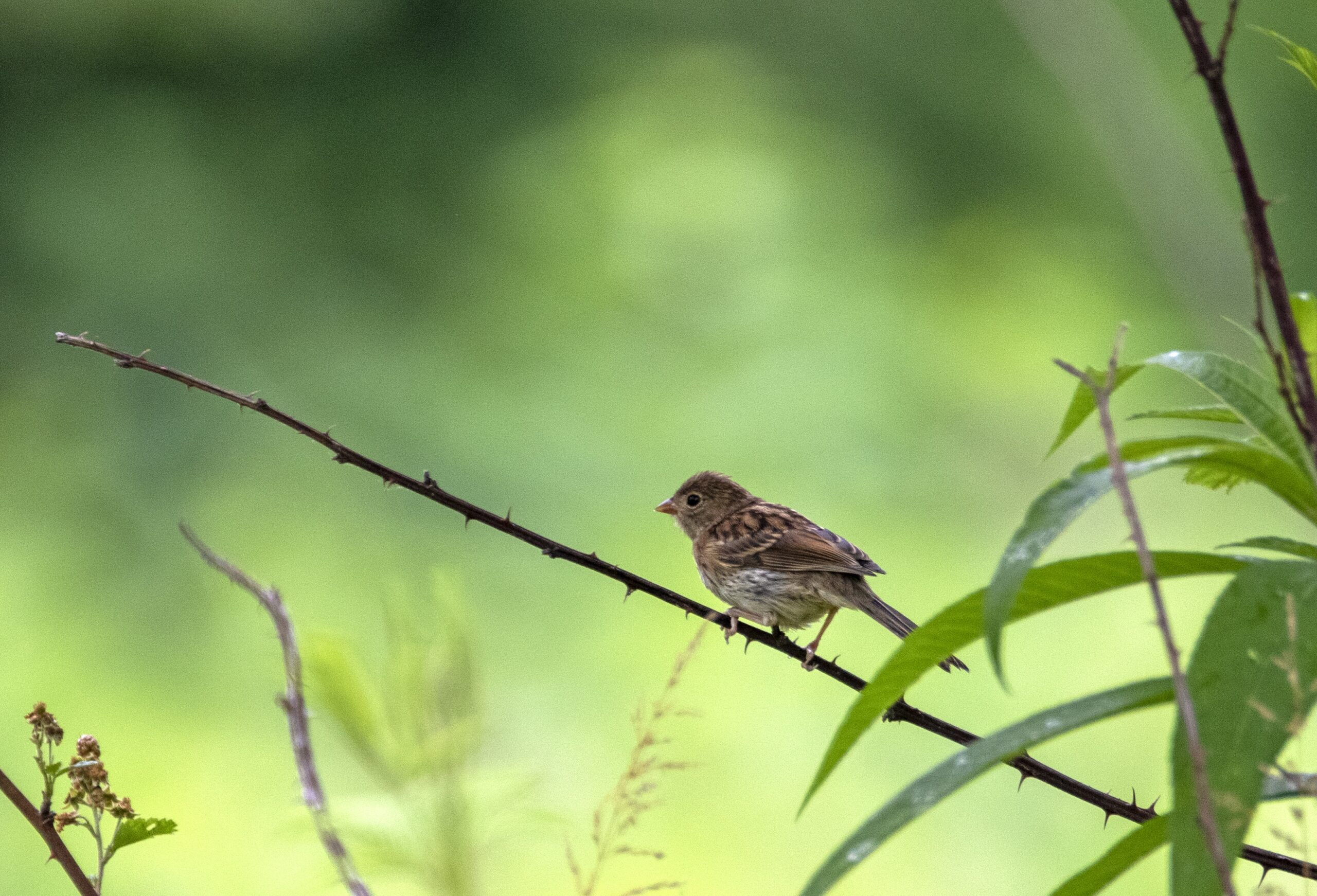
- The plaintive whistled song of the Field Sparrow often can be heard in brushy pastures, even on hot summer days when most birds are silent. Despite the name, this is not one of the sparrows inhabiting open fields of grass; it prefers brushy places, overgrown meadows with many bushes. It looks distinctively small and long-tailed, and its plain face gives it an innocent expression to match the sweetness of its song. In winter, Field Sparrows gather in small flocks.
- Ginny Fowl
- Goose
- Gray Catbird –
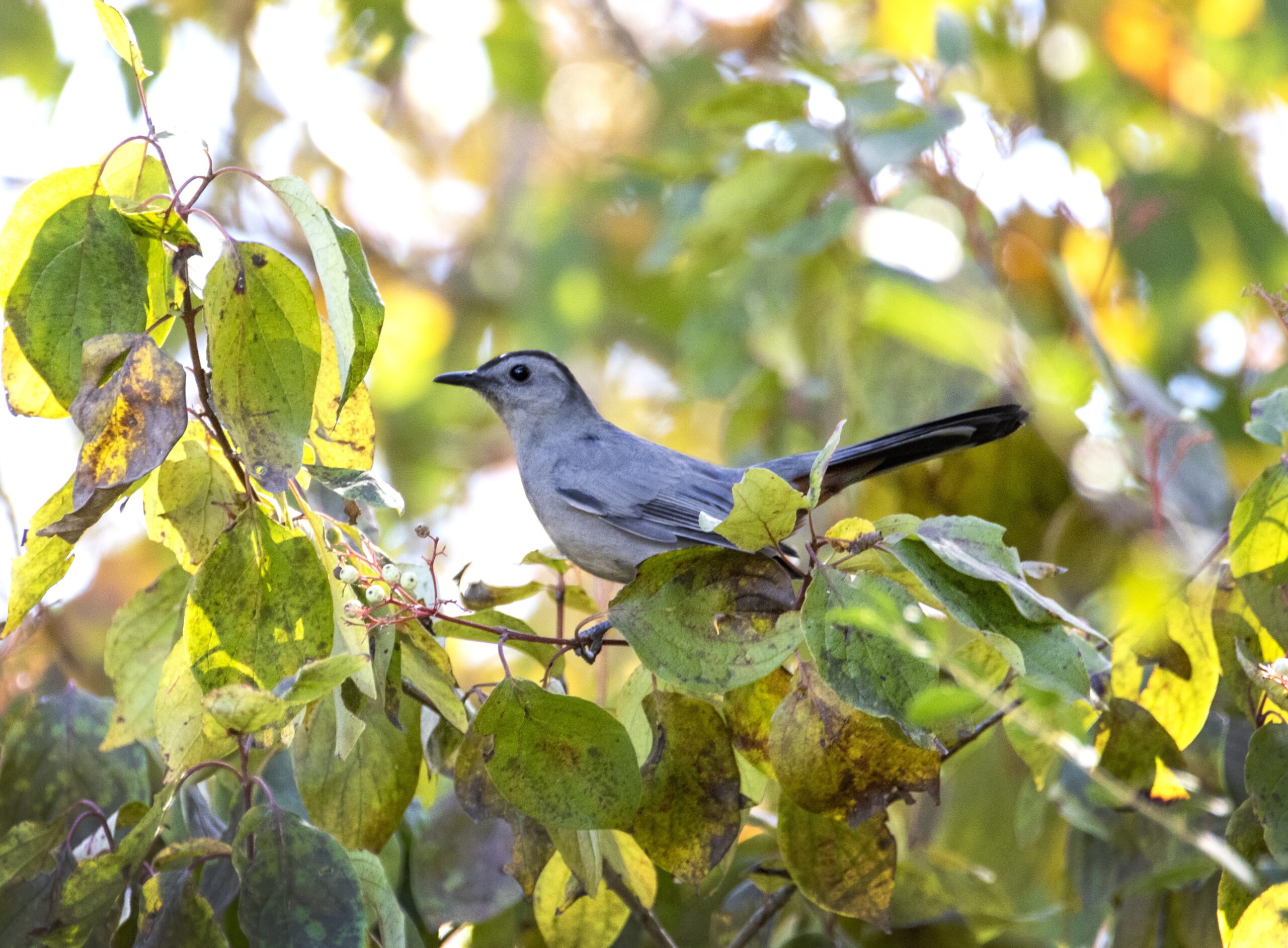
- Rather plain but with lots of personality, the Gray Catbird often hides in the shrubbery, making an odd variety of musical and harsh sounds — including the catlike mewing responsible for its name. At other times it moves about boldly in the open, jerking its long tail expressively. Most catbirds winter in the southern United States or the tropics, but a few linger far to the north if they have access to a reliable source of berries or a well-stocked bird feeder.
- Great Blue Heron –

- Widespread and familiar (though often called ‘crane’), the largest heron in North America. Often seen standing silently along inland rivers or lakeshores, or flying high overhead, with slow wingbeats, its head hunched back onto its shoulders. Highly adaptable, it thrives around all kinds of waters from subtropical mangrove swamps to desert rivers to the coastline of southern Alaska. With its variable diet it is able to spend the winter farther north than most herons, even in areas where most waters freeze. A form in southern Florida (called ‘Great White Heron’) is slightly larger and entirely white.
- Great Crested Flycatcher –
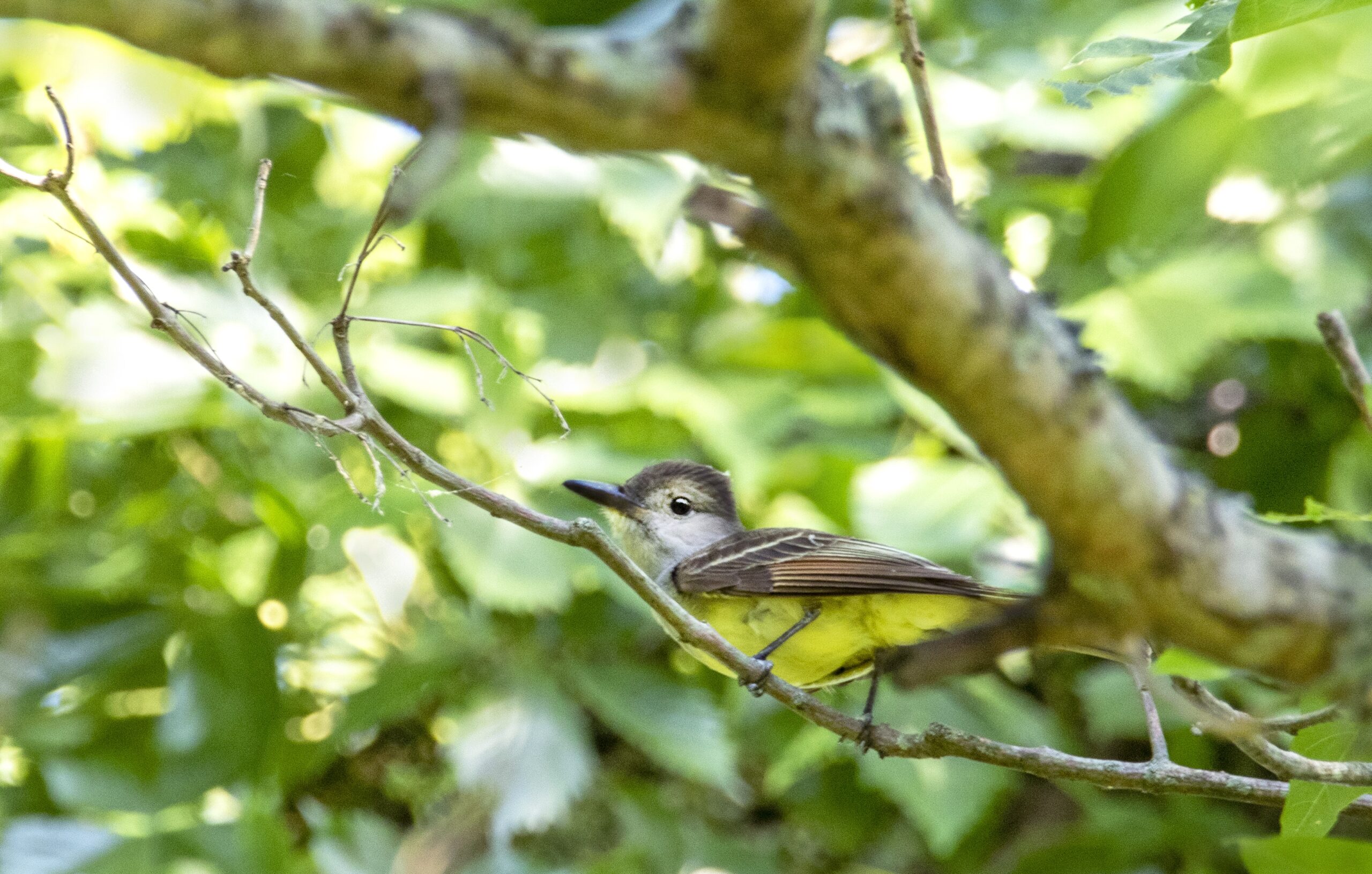
- In dense leafy forests of the east, the Great Crested Flycatcher lives within the canopy of tall trees in summer. It is more easily heard than seen, its rolling calls echoing through the woods. The birder who pursues and sees the bird is likely to be impressed; this species is much more colorful than most flycatchers in the east. It nests in holes in trees, and it has the odd habit of adding pieces of shed snakeskin to its nest.
- House Finch –

- Adaptable, colorful, and cheery-voiced, House Finches are common from coast to coast today, familiar visitors to backyard feeders. Native to the Southwest, they are recent arrivals in the East. New York pet shop owners, who had been selling the finches illegally, released their birds in 1940 to escape prosecution; the finches survived, and began to colonize the New York suburbs. By 50 years later they had advanced halfway across the continent, meeting their western kin on the Great Plains.
- Indigo Bunting –
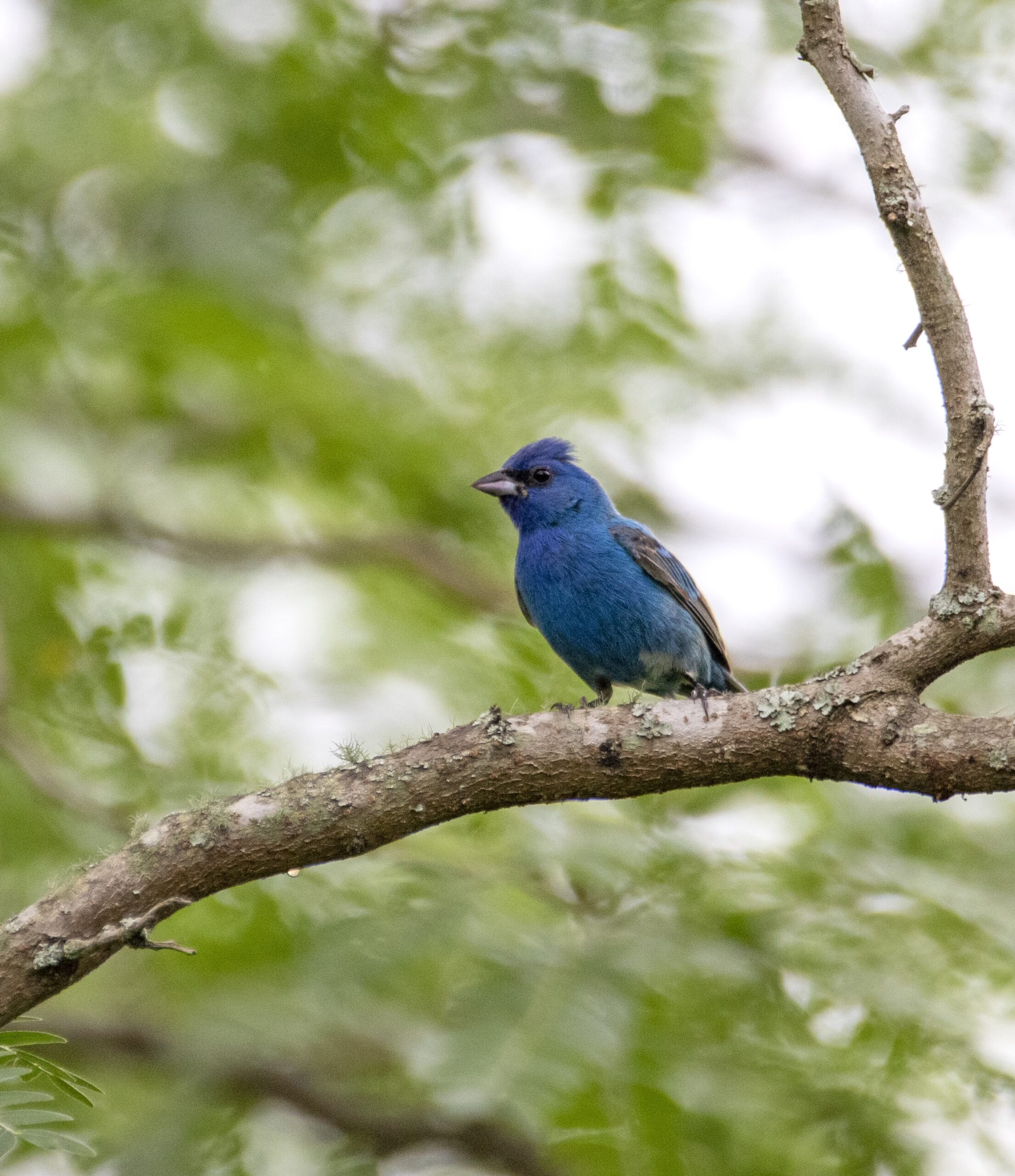
- In parts of the East, Indigo Bunting may be the most abundant songbird, with the deep-blue males singing along every roadside. The plain brown females are seen far less often, and they have good reason to be inconspicuous: they do almost all the work of caring for the eggs and young, hidden away in dense thickets. This species favors brushy edges rather than unbroken forest, and is probably far more common today than when the Pilgrims landed.
- Magnolia Warbler –

- Although it is small and very active, the Magnolia Warbler is not as difficult to observe as some warblers, because it often stays low in shrubbery and short trees. It favors second-growth habitats both summer (in the north woods) and winter (in the tropics), so it has not been hurt by habitat destruction as much as some migrants. Named by chance, since pioneer ornithologist Alexander Wilson happened to spot his first one in a southern magnolia tree during migration.
- Mourning Dove –
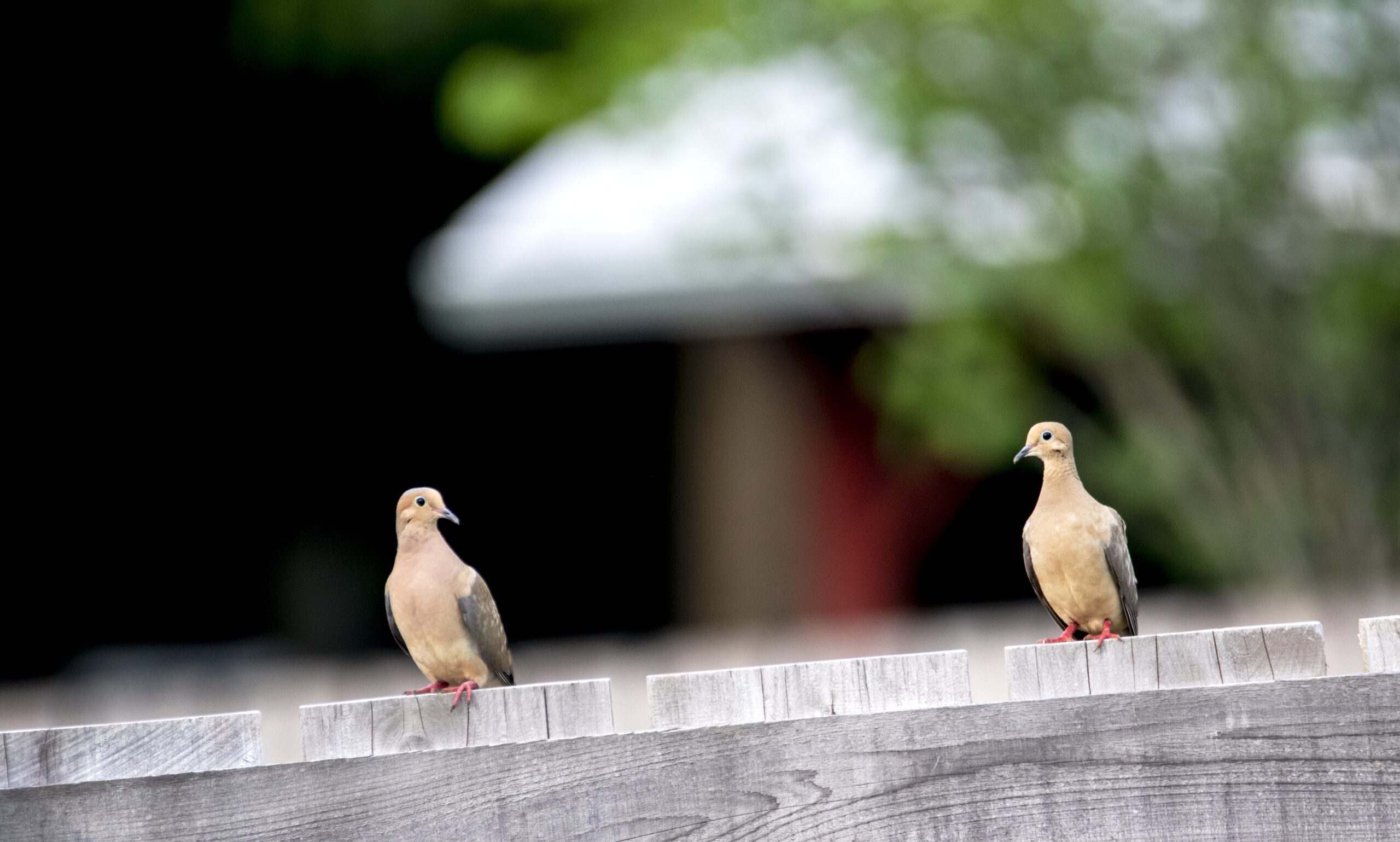
- The mournful cooing of the Mourning Dove is one of our most familiar bird sounds. From southern Canada to central Mexico, this is one of our most common birds, often abundant in open country and along roadsides. European settlement of the continent, with its opening of the forest, probably helped this species to increase. It also helps itself, by breeding prolifically: in warm climates, Mourning Doves may raise up to six broods per year, more than any other native bird.
- Northern Cardinal –

- One of our most popular birds, the Cardinal is the official state bird of no fewer than seven eastern states. Abundant in the Southeast, it has been extending its range northward for decades, and it now brightens winter days with its color and its whistled song as far north as southeastern Canada. Feeders stocked with sunflower seeds may have aided its northward spread. West of the Great Plains, the Cardinal is mostly absent, but it is locally common in the desert Southwest.
- Northern Flicker –
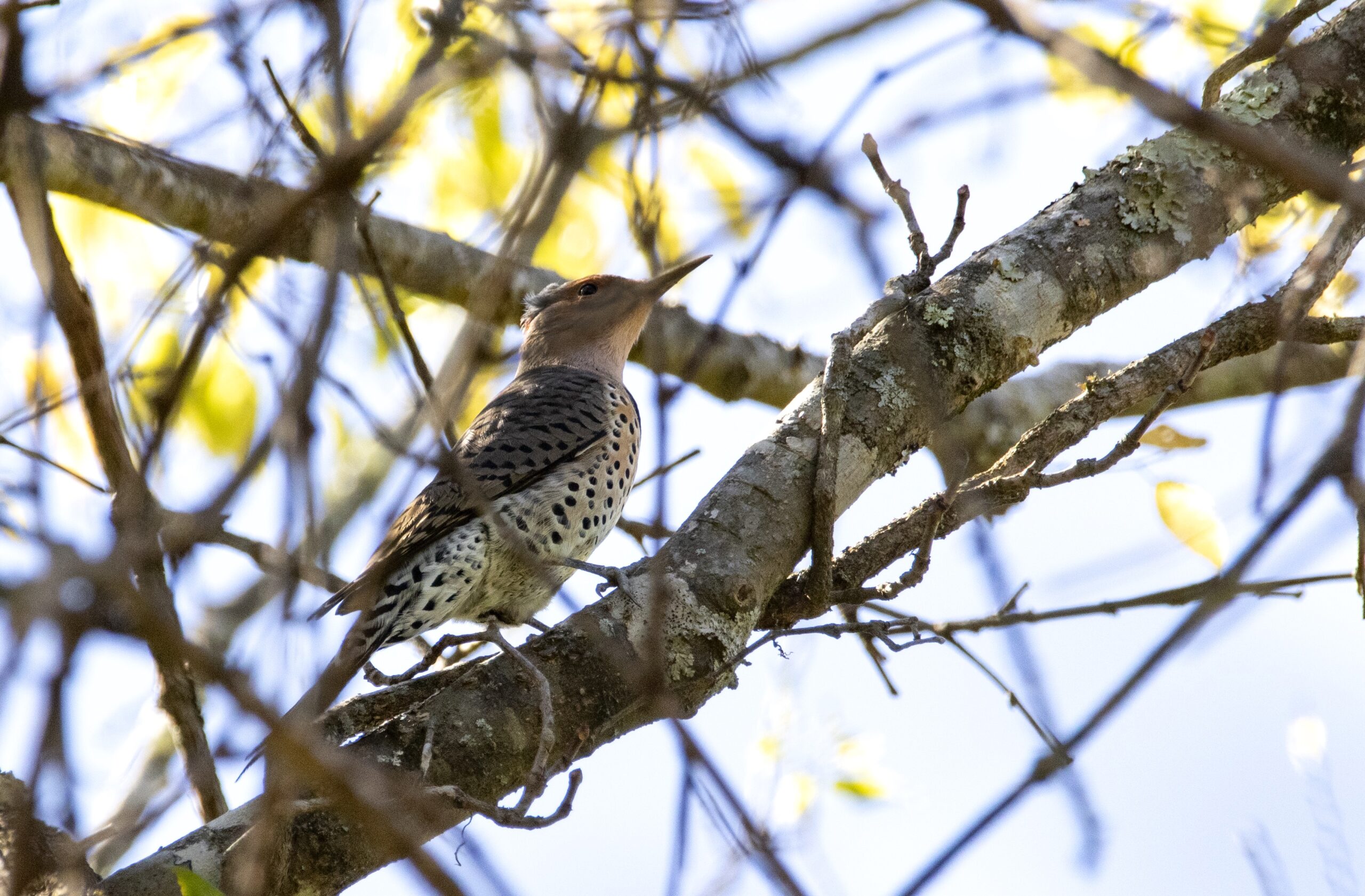
- This brown woodpecker flashes bright colors under the wings and tail when it flies. Its ringing calls and short bursts of drumming can be heard in spring almost throughout North America. Two very different-looking forms — Yellow-shafted Flicker in the east and north, and Red-shafted Flicker in the west — were once considered separate species. They interbreed wherever their ranges come in contact. On the western Great Plains, there is a broad zone where all the flickers are intergrades between Red-shafted and Yellow-shafted.
- Northern Mockingbird –
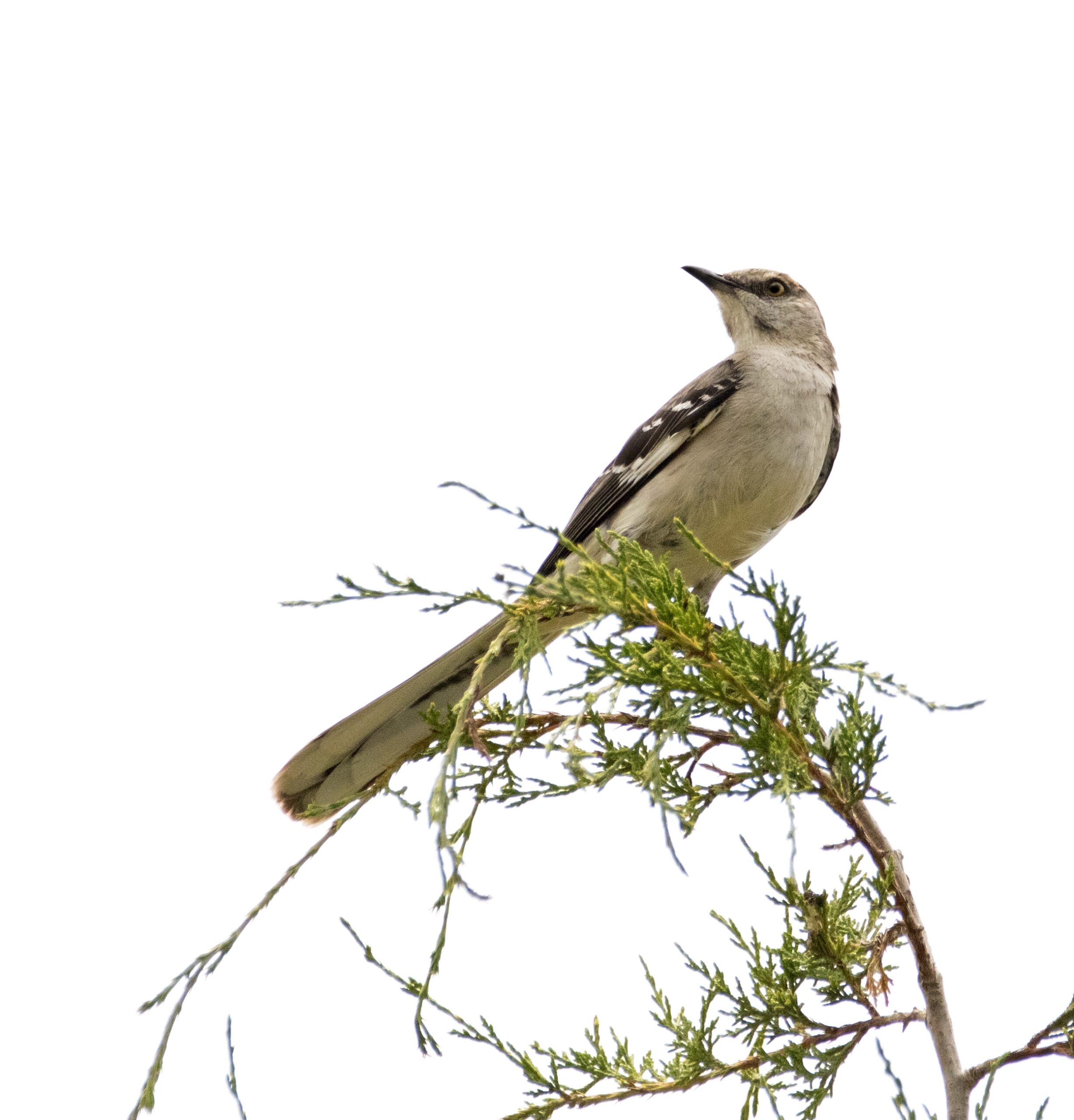
- This bird’s famous song, with its varied repetitions and artful imitations, is heard all day during nesting season (and often all night as well). Very common in towns and cities, especially in southern areas, the Mockingbird often seeks insects on open lawns. When running in the open it may stop every few feet and partly spread its wings, flashing the white wing patches. Mockingbirds are bold in defense of their nests, attacking cats and even humans that venture too close.
- Northern Parula –
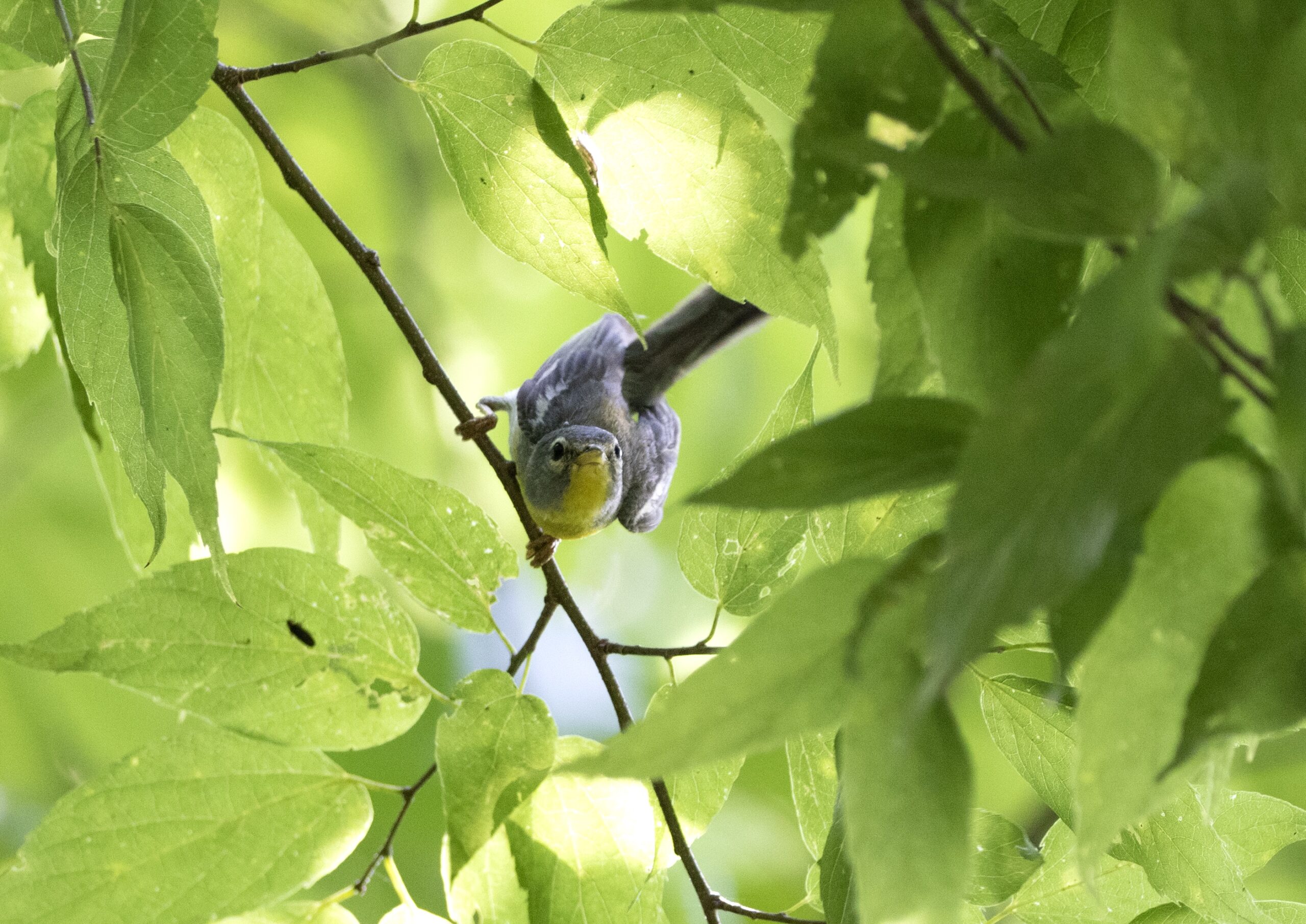
- This small warbler is often hard to see as it forages in dense foliage of the treetops. However, it is easy to hear; the male seems to repeat his buzzy trickle-up song constantly from early spring through mid-summer at least. Northern Parulas hide their nests inside hanging Spanish moss in the South, or in the similar Usnea lichens in the North, where they are impossible to spot except by the actions of the parent birds.
- Northern Waterthrush –
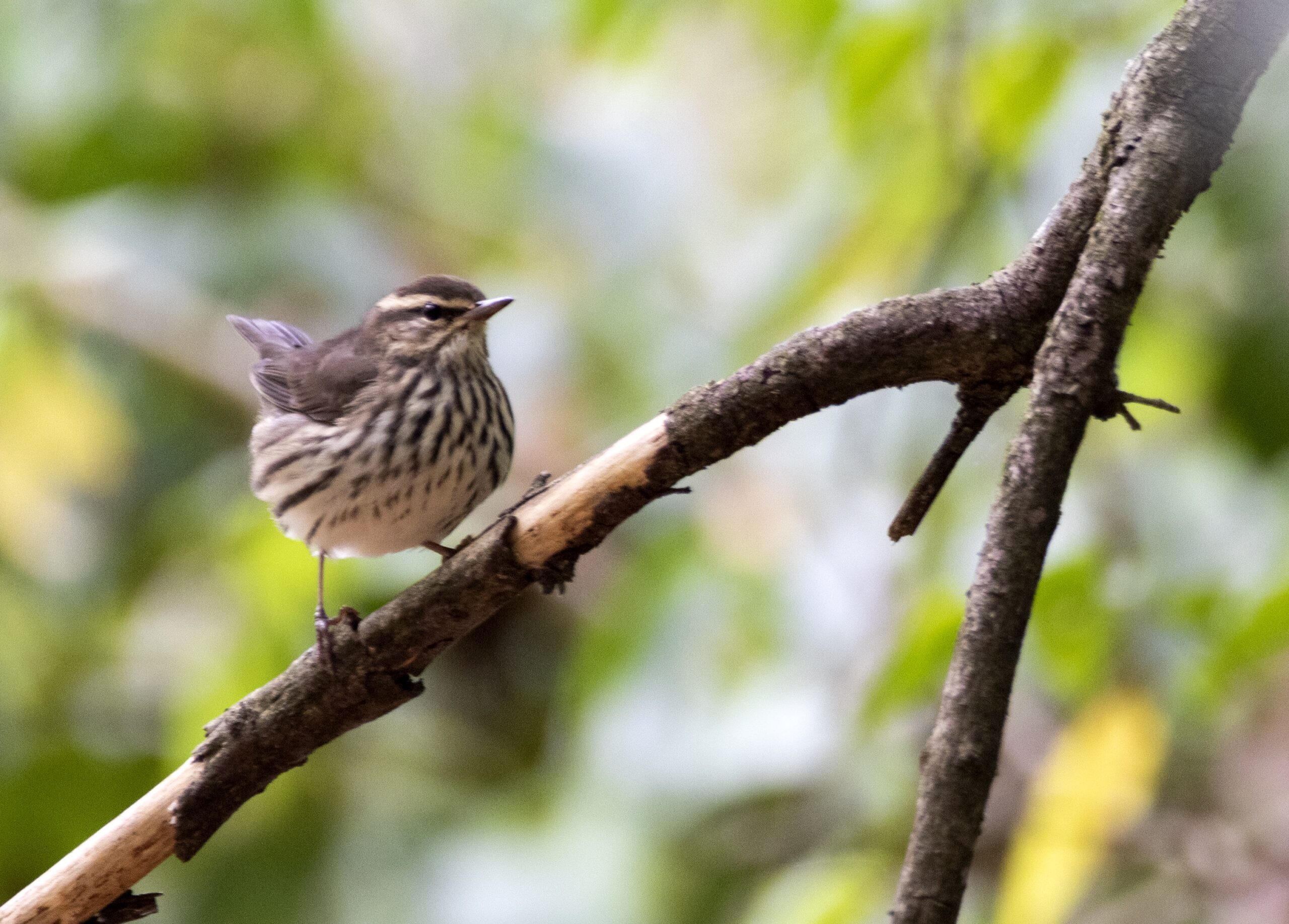
- The Northern Waterthrush is likely to be found around bogs and streams inside the forest. Often shy and hard to approach, it draws attention with its odd ‘teetering’ behavior — bobbing the rear half of its body up and down constantly as it walks — and with its loud metallic callnote. It has a wide distribution in both summer (Alaska to New Jersey) and winter (Florida to South America).
- Orchard Oriole –

- Most common in the Midwest and South is this small oriole. It favors open areas with scattered groves of trees, so human activities may have helped it in some areas, opening up the eastern woodlands and planting groves of trees on the prairies. Orchard Orioles often gather in flocks during migration. The black-throated young male, sitting alone in a treetop and singing his jumbled song, is often confusing to beginning birders.
- Palm Warbler –
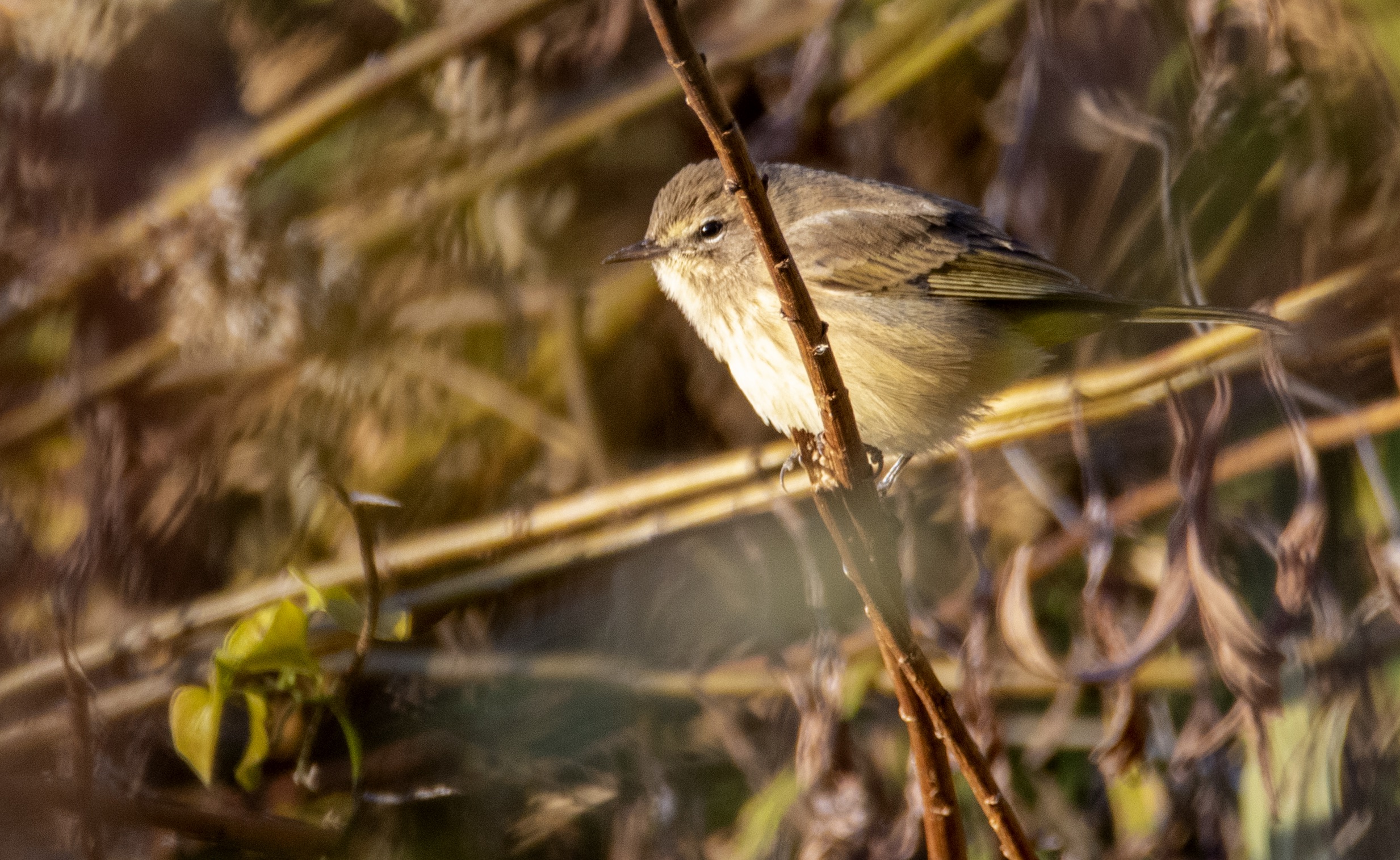
- A bird of thickets and open areas, usually seen low or on the ground. Birds from the easternmost part of the range (‘Yellow Palm Warblers’) are rather colorful, but most others are quite drab; however, they can be recognized by the constant bobbing of their tails. Many Palm Warblers spend the winter in the southeastern United States, especially in Florida, where they may be seen near palm groves but not up in the palms themselves.
- Red-bellied Woodpecker –
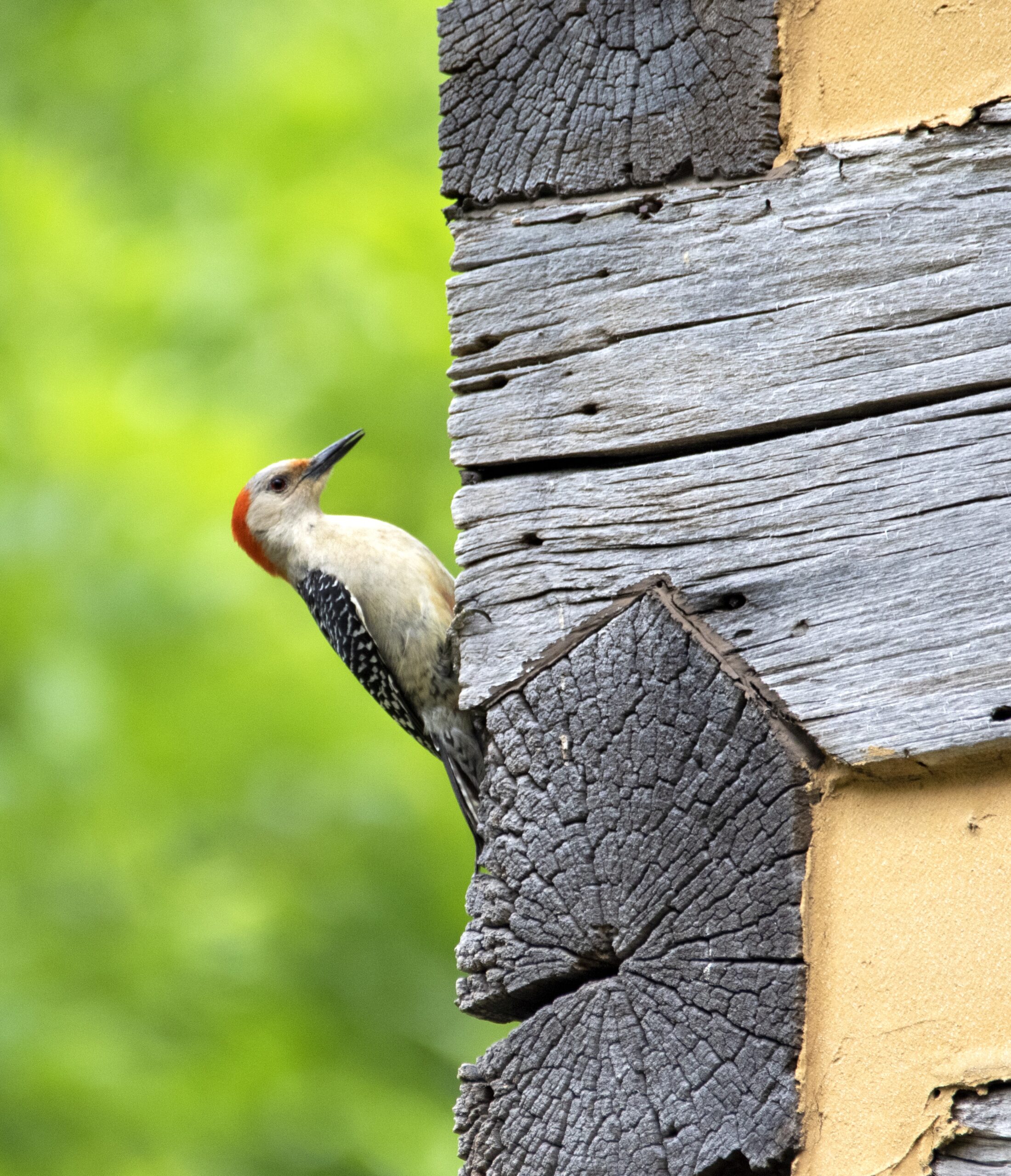
- Primarily a bird of the southeast, where its rolling calls are familiar sounds in swamps and riverside woods. Omnivorous and adaptable, this woodpecker has also adjusted to life in suburbs and city parks, and in recent years it has been expanding its range to the north. Despite the name, the red on the belly is not often visible in the field.
- Red-shouldered Hawk –
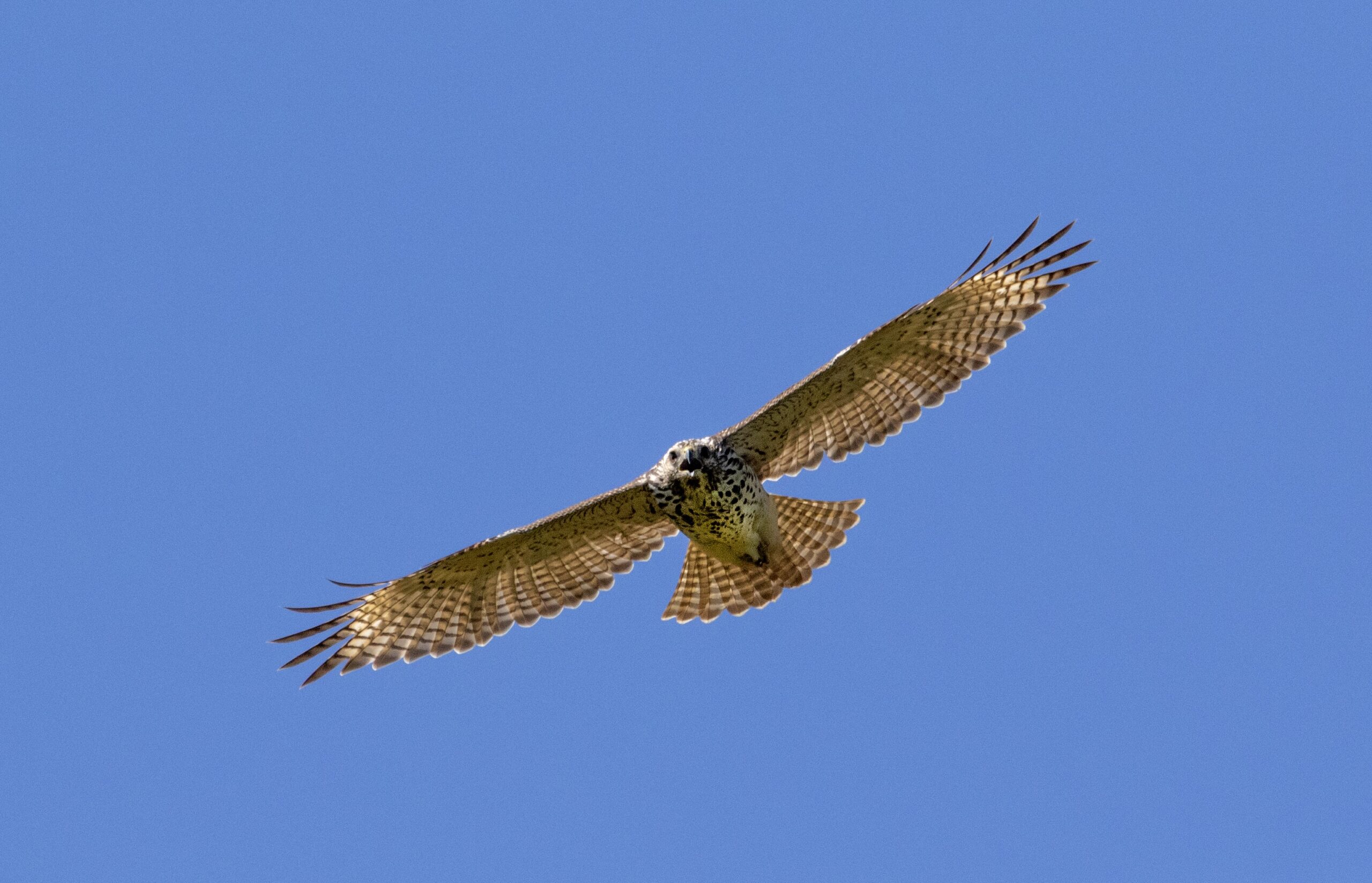
- A hawk of the woodlands, often heard before it is seen. The clear whistled calls of this hawk are conspicuous, especially in spring; in the east, Blue Jays often give a near-perfect imitation of this call. Over much of eastern North America the Red-shoulder has become uncommon, sticking closely to the remaining forests. Populations in Florida and California are often more visible, perhaps adapting better to open habitats.
- Red-tailed Hawk –
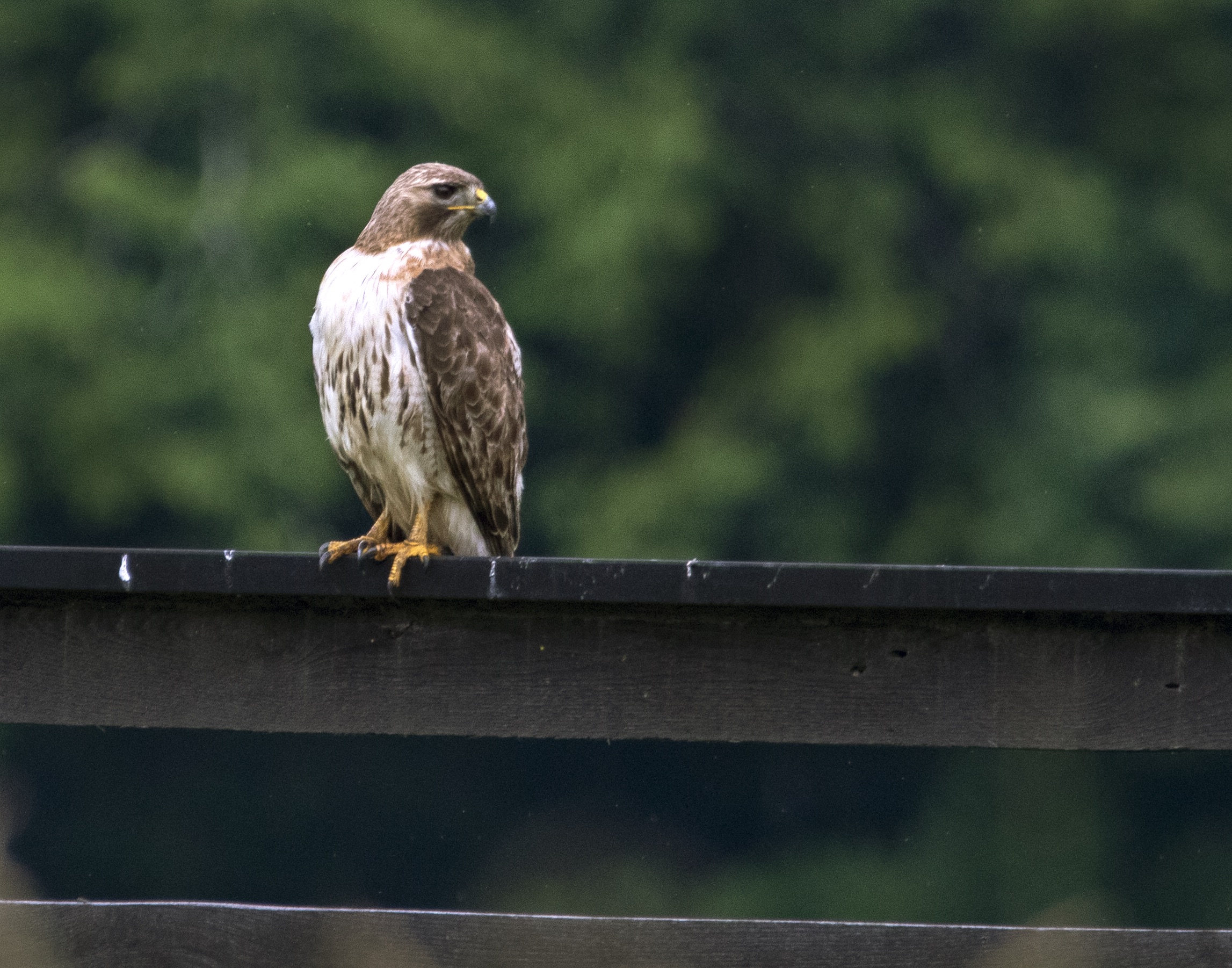
- This is the most widespread and familiar large hawk in North America, bulky and broad-winged, designed for effortless soaring. An inhabitant of open country, it is commonly seen perched on roadside poles or sailing over fields and woods. Although adults usually can be recognized by the trademark reddish-brown tail, the rest of their plumage can be quite variable, especially west of the Mississippi: Western Red-tails can range from blackish to rufous-brown to nearly white.
- Ruby-crowned Kinglet –
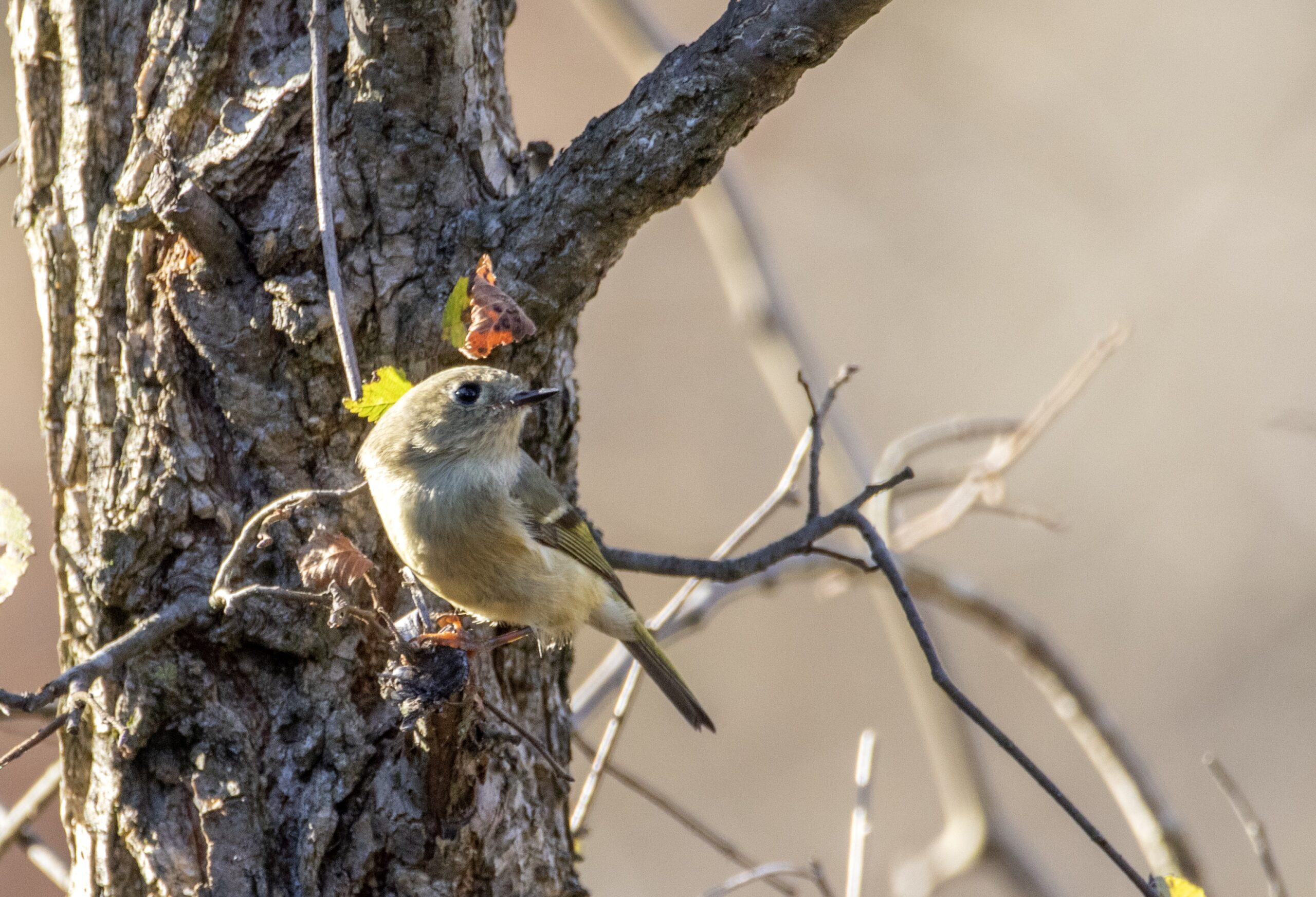
- This tiny bird is often hard to see in summer, when it lives high in tall conifers. In migration and winter, however, it often flits about low in woods and thickets, flicking its wings nervously as it approaches the observer. When it is truly excited (by a potential mate, rival, or predator), the male may erect his ruby-red crown feathers, hidden at other times. The song of the Ruby-crown is jumbled and loud, all out of proportion to the size of the bird.
- Ruby-throated Hummingbird –
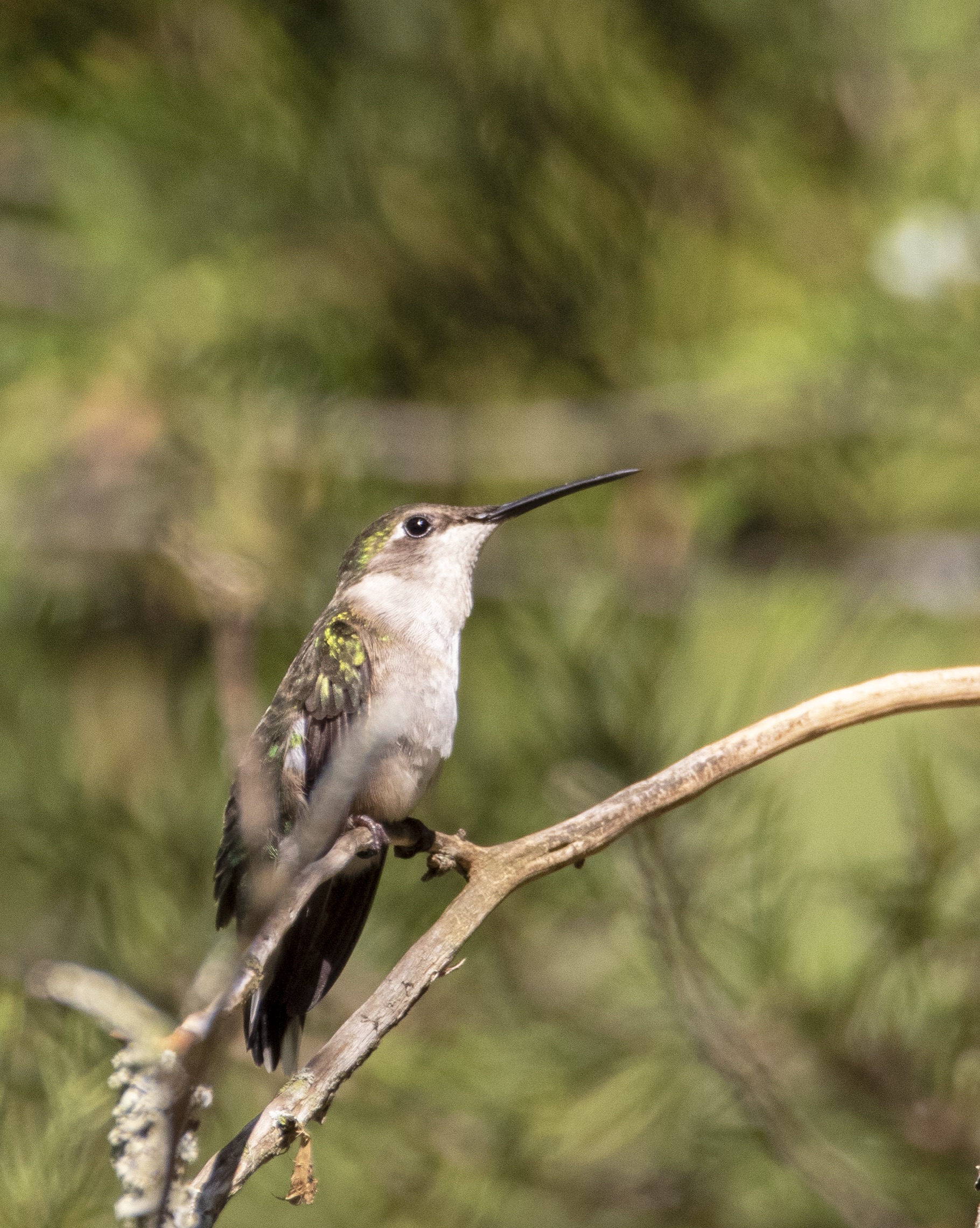
- Hundreds of kinds of hummingbirds nest in the American tropics, and more than a dozen in the western U.S., but east of the Great Plains there is only the Ruby-throat. There it is fairly common in summer in open woods and gardens. Hovering in front of a flower to sip nectar, it beats its wings more than 50 times per second. Impressive migrants despite their small size, some Ruby-throats may travel from Canada to Costa Rica.
- Song Sparrow –
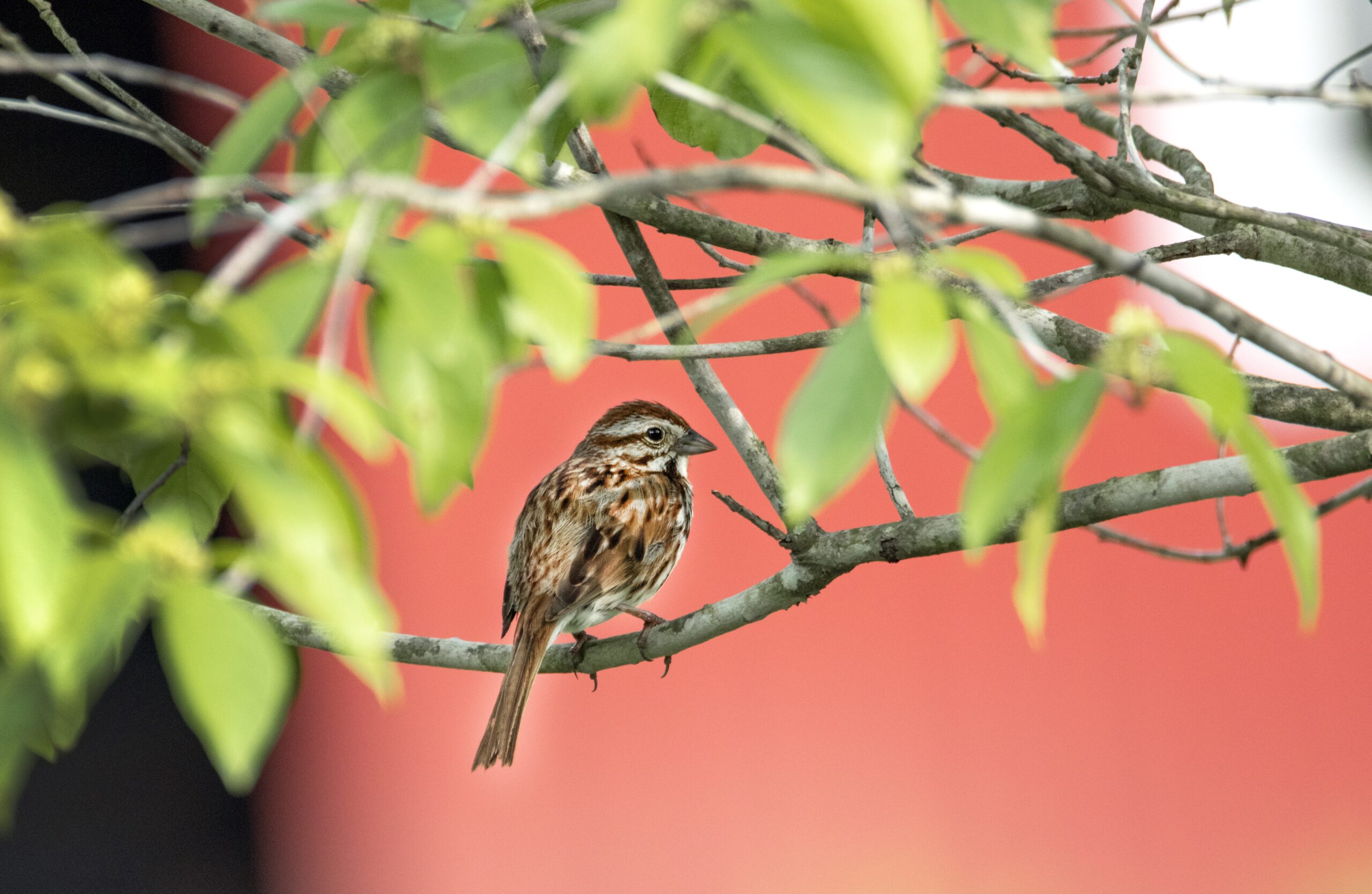
- Very widespread in North America, this melodious sparrow is among the most familiar birds in some areas, such as the Northeast and Midwest. At times it is rather skulking in behavior, hiding in the thickets, seen only when it flies from bush to bush with a typical pumping motion of its tail. Usually, however, sheer numbers make it conspicuous. Song Sparrows vary in appearance over their wide range, from large dark birds on the Aleutians to small pale ones in the desert Southwest.
- European Starling –
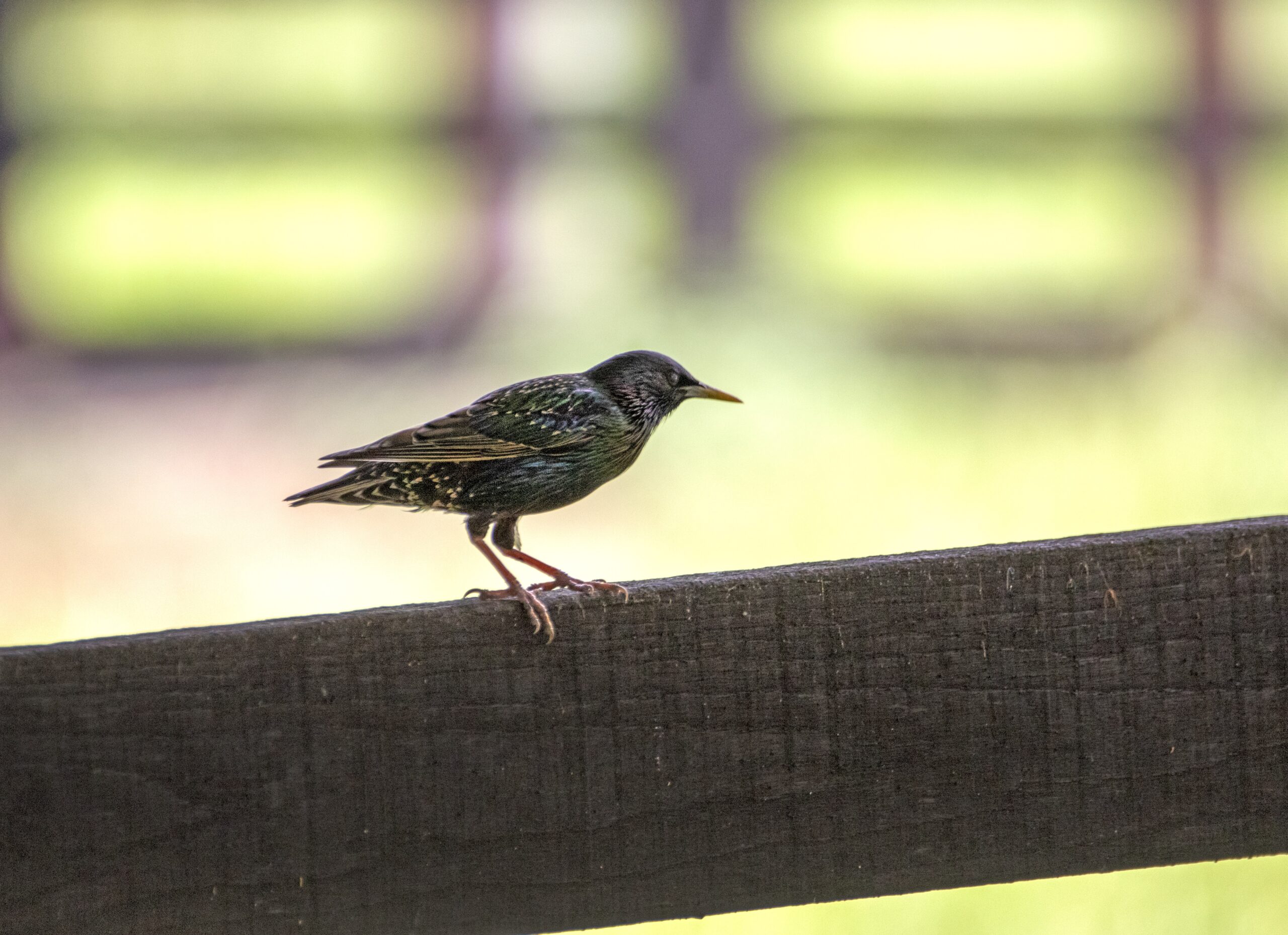
- Often regarded as a pest, the Starling wins our grudging admiration for its adaptability, toughness, and seeming intelligence. Brought to North America in 1890, it has spread to occupy most of the continent, and is now abundant in many areas. Sociable at most seasons, Starlings may gather in immense flocks in fall and winter. When the flocks break up for the breeding season, males reveal a skill for mimicry, interrupting their wheezing and sputtering songs with perfect imitations of other birds.
- Summer Tanager –
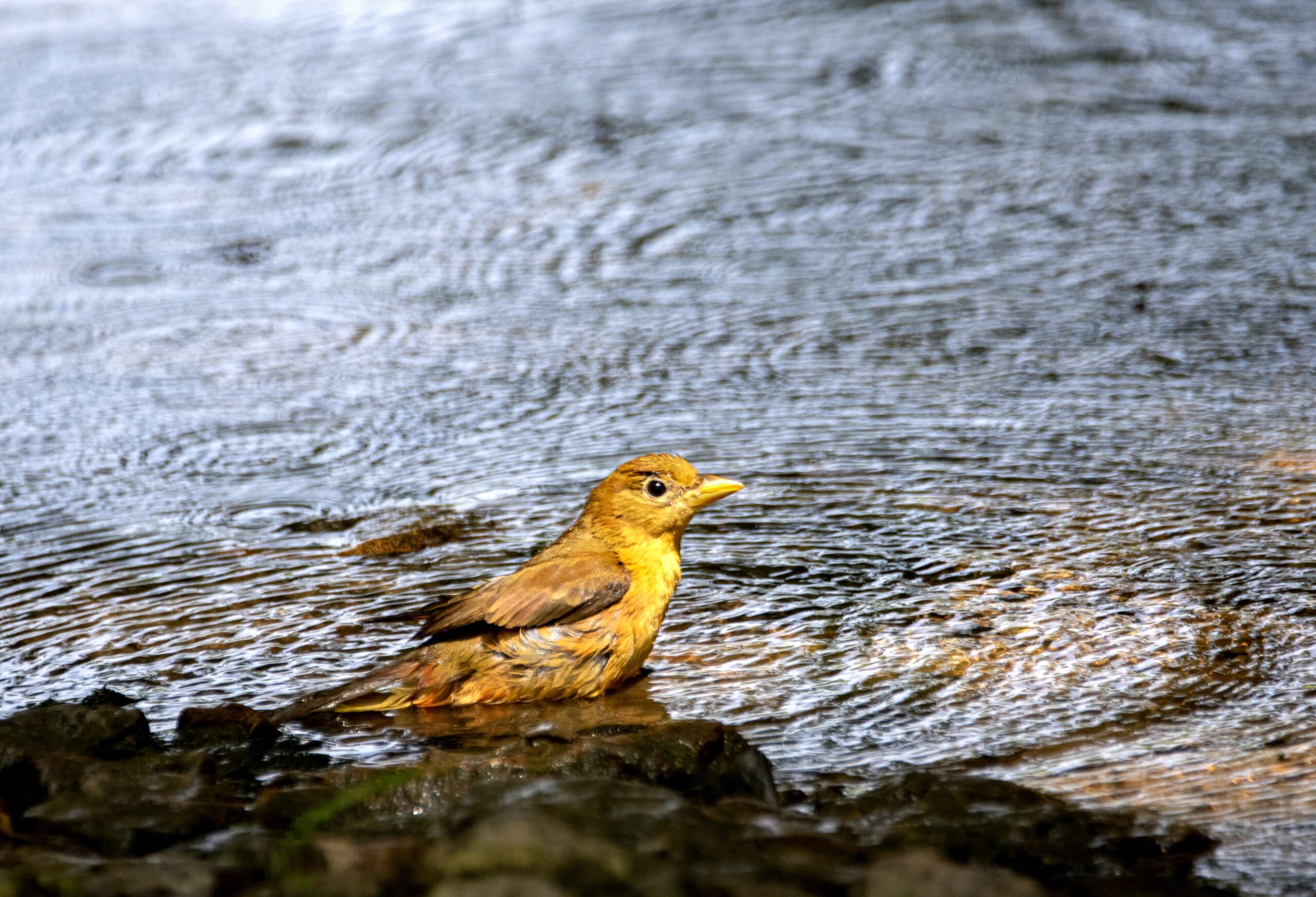
- A languid song in southern woods, sounding like a lazy robin, is the voice of the Summer Tanager. Seeing the bird may require some patience, because it usually moves rather slowly in the treetops, often remaining hidden among the leaves. At times, however, it flies out conspicuously to catch flying insects in mid-air. This bird apparently has no fear of stinging insects, often raiding wasp nests and occasionally becoming a minor nuisance around beehives.
- Tufted Titmouse –
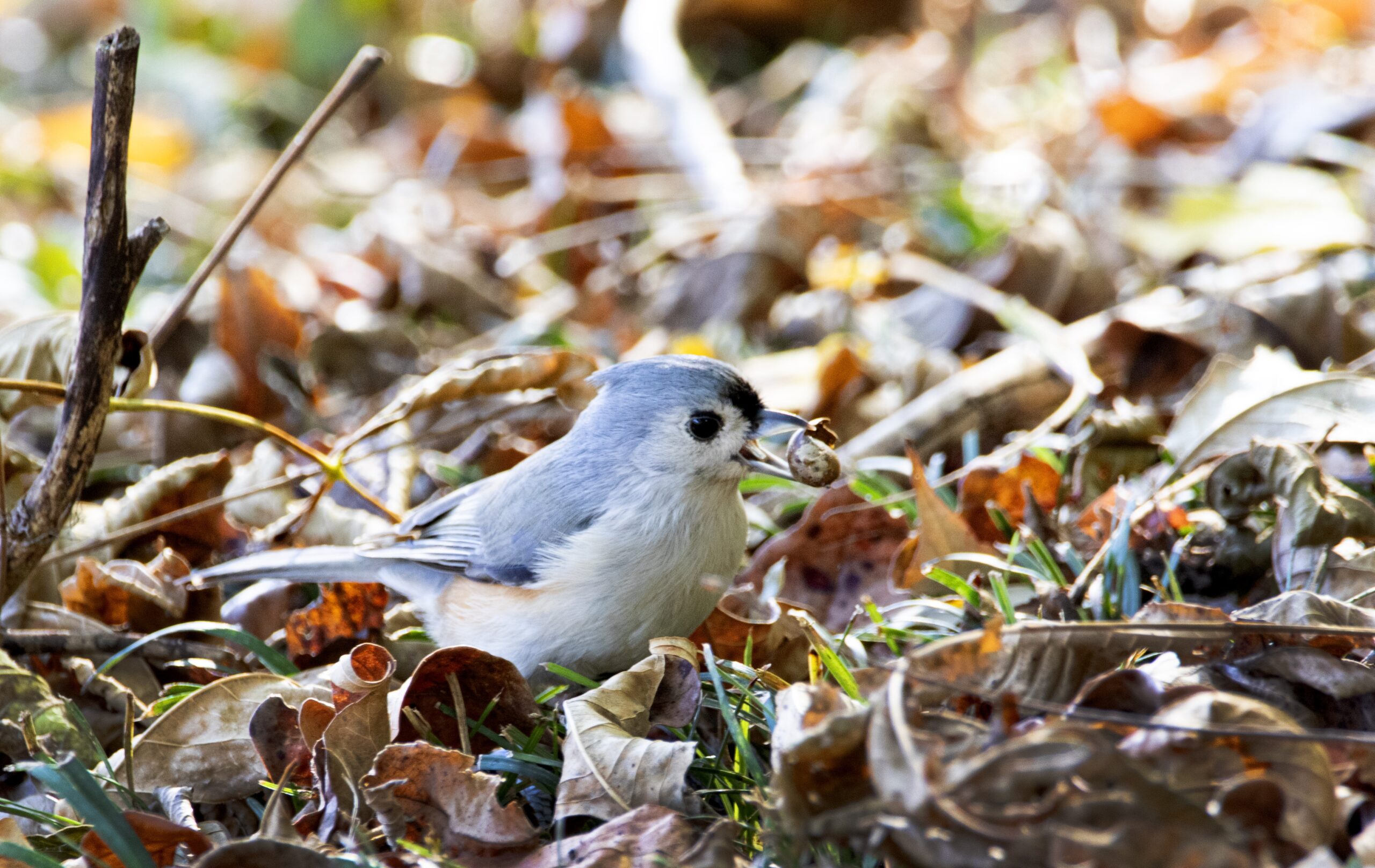
- This rather tame, active, crested little bird is common all year in eastern forests, where its whistled peter-peter-peter song may be heard even during mid-winter thaws. It is related to the chickadees, and like them it readily comes to bird feeders, often carrying away sunflower seeds one at a time. Feeders may be helping it to expand its range: in recent decades, Tufted Titmice have been steadily pushing north.
- Turkey Vulture –

- A familiar sight in the sky over much of North America is the dark, long-winged form of the Turkey Vulture, soaring high over the landscape. Most birds are believed to have a very poor sense of smell, but the Turkey Vulture is an exception, apparently able to find carrion by odor.
- White-breasted Nuthatch –

- Readily attracted to bird feeders for sunflower seeds or suet, the White-breasted Nuthatch may spend much of its time industriously carrying seeds away to hide them in crevices. Its nasal calls are typical and familiar sounds of winter mornings in deciduous woods over much of North America.
- White-eyed Vireo –
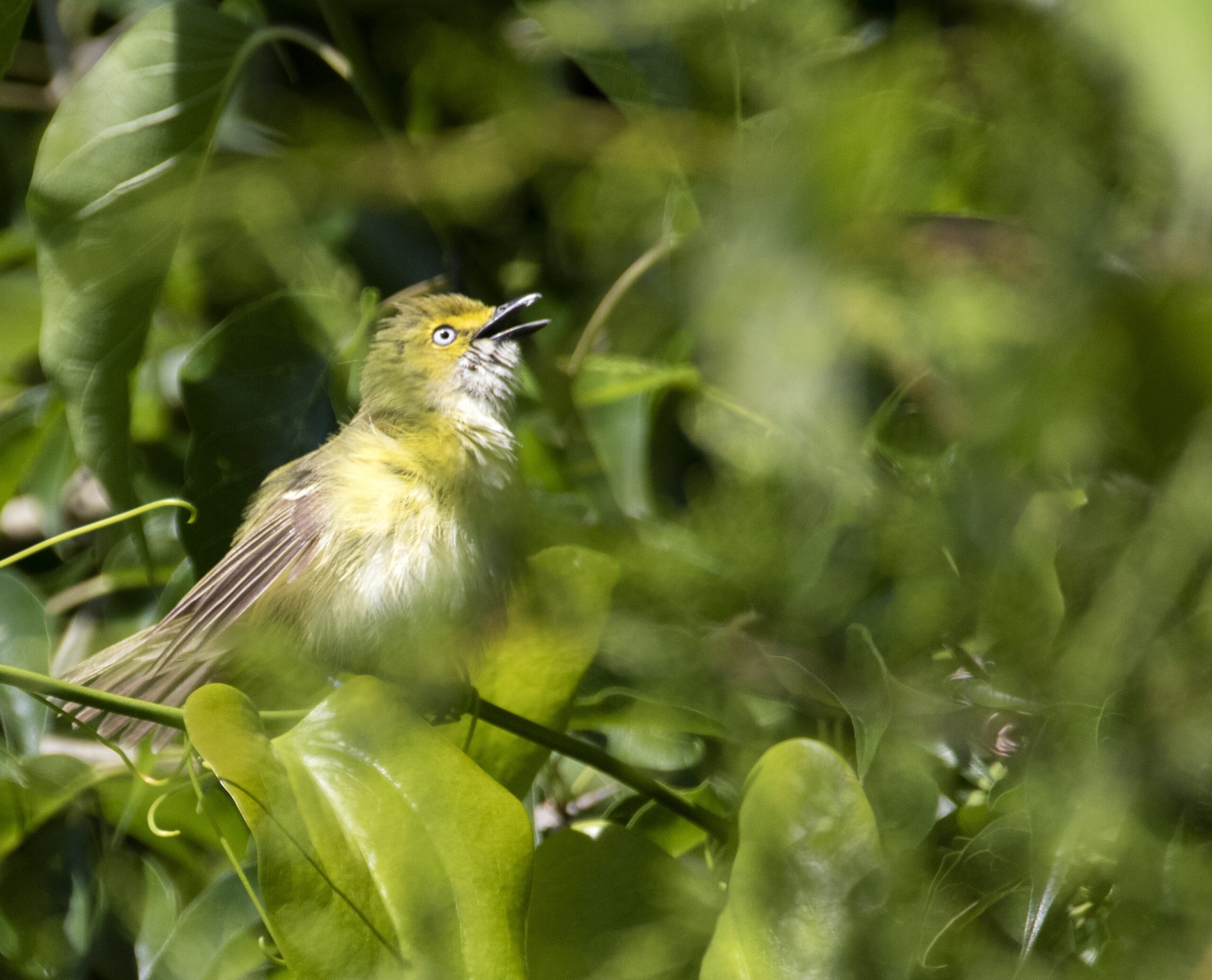
- A busy bird of the thickets, most common in the southeast. Although the White-eyed Vireo usually stays in dense cover, it is not always hard to see; it will come up to examine and scold a birder who stands near the bushes and makes squeaking sounds. Even when it remains out of sight, its snappy song is distinctive. In Bermuda, where the bird is common, it is widely known as ‘chick-of-the-village,’ a good rendition of the song.
- White-throated Sparrow –

- A common winter bird of eastern woodlots, shuffling about on the ground in loose flocks, often coming to bird feeders that are placed close enough to the shelter of thickets. It is also widespread in the West in winter, but in much smaller numbers. In summer, White-throated Sparrows sing their clear whistles in northern forests. Adults may have head stripes of either white or tan, and scientists have found some odd differences in behavior between these two color morphs.
- Wild Turkey –
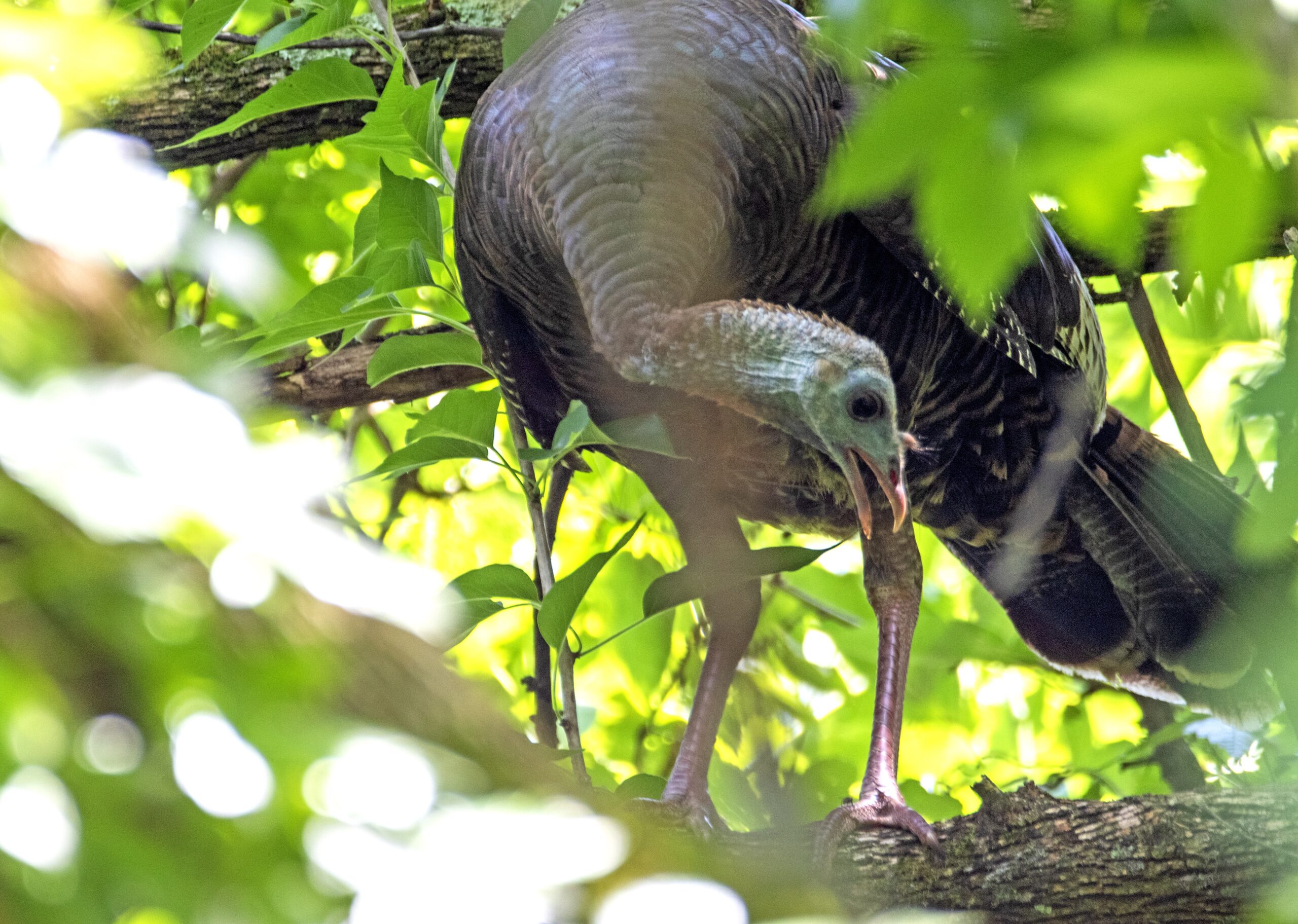
- Benjamin Franklin would have preferred to have the Wild Turkey, not the Bald Eagle, chosen as the national symbol of the United States. Although the barnyard variety is a rather stupid creature (leading to the insulting tone of the term ‘turkey’), the original wild form is a wary and magnificent bird. Wild Turkeys usually get around by walking or running, but they can fly strongly, and they typically roost overnight in tall trees. Turkeys were formerly considered to belong to a separate family from other chicken-like birds; there are only two species, ours in North America and the Ocellated Turkey in Central America.
- Wood Thrush –
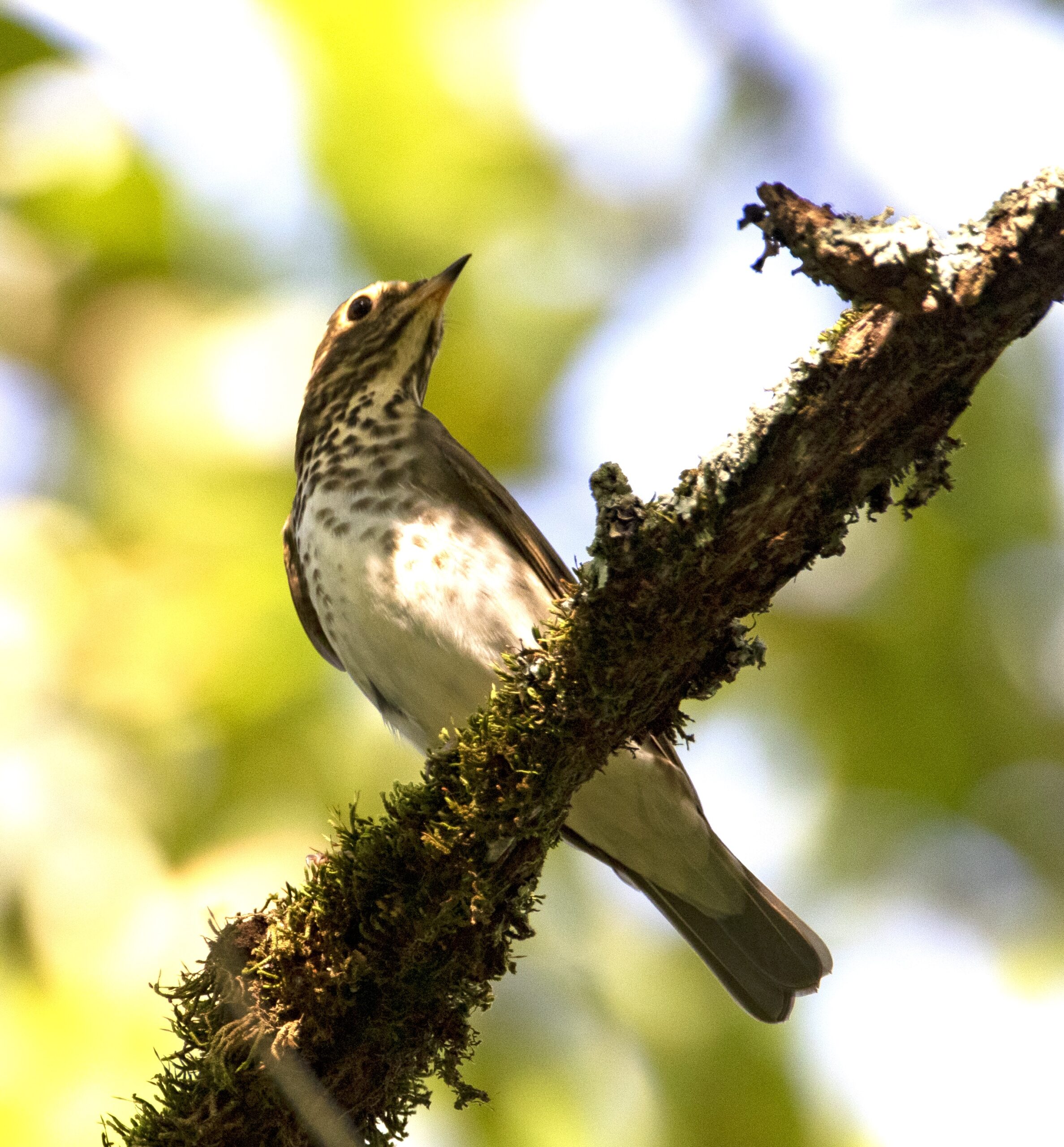
- Seemingly not as shy as the other brown thrushes, not as bold as the Robin, the Wood Thrush seems intermediate between those two related groups. It sometimes nests in suburbs and city parks, and it is still common in many eastern woodlands, where its flutelike songs add music to summer mornings. However, numbers of Wood Thrushes have declined seriously in recent decades, focusing the attention of conservationists on the problems facing our migratory birds.
- Yellow-bellied Sapsucker –

- Although its name sounds like a cartoonist’s invention, the Yellow-bellied Sapsucker does exist. This species is common in the north and east, and is replaced by close relatives in the west. Quiet in winter, it becomes noisy in spring, with cat-like calls and staccato drumming.
- Yellow-billed Cuckoo –
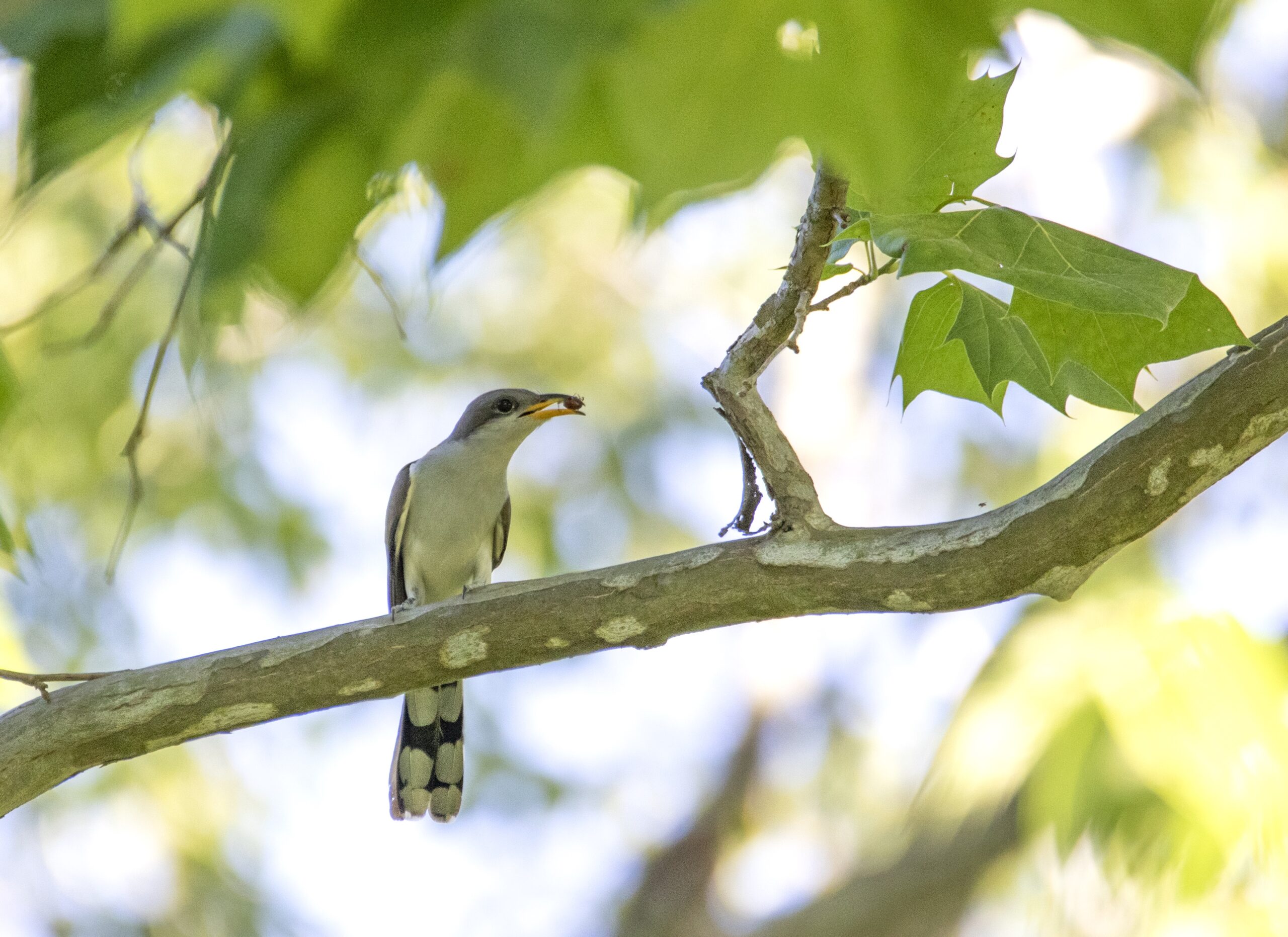
- Sometimes common but usually hard to observe, the Yellow-billed Cuckoo inhabits dense leafy groves and thickets during the summer. Its stuttering, croaking calls, audible at a great distance, are often heard on hot, humid afternoons; people sometimes call this bird the ‘rain crow,’ imagining that it is calling for rain.
- Yellow-breasted Chat –
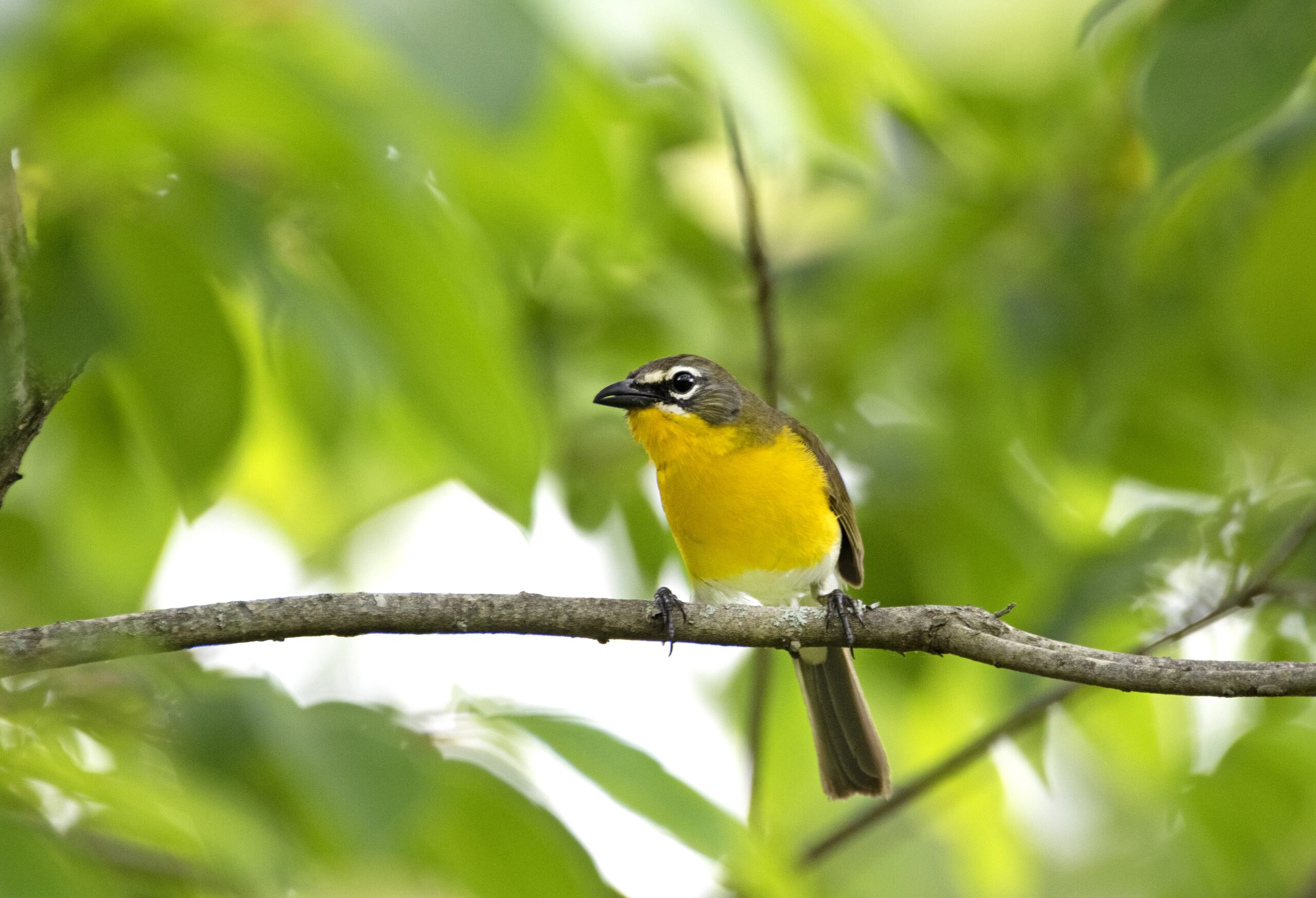
- A bizarre series of hoots, whistles, and clucks, coming from the briar tangles, announces the presence of the Yellow-breasted Chat. The bird is often hard to see, but sometimes it launches into the air to sing its odd song as it flies, with floppy wingbeats and dangling legs, above the thickets. This is our largest warbler, and surely the strangest as well, seeming to suggest a cross between a warbler and a mockingbird.
- Yellow-rumped Warbler –
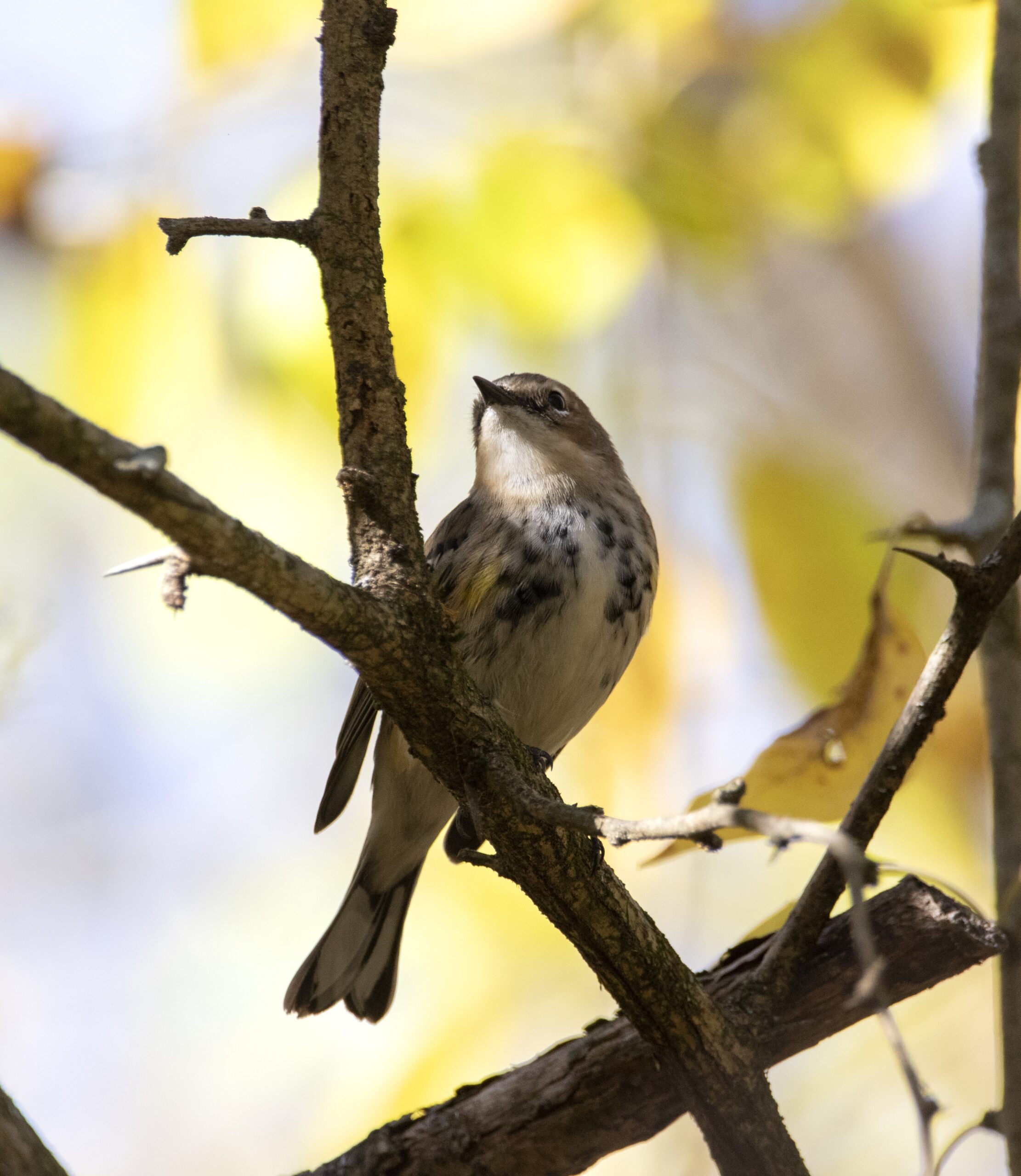
- Flashing its trademark yellow rump patch as it flies away, calling check for confirmation, this is one of our best-known warblers. While most of its relatives migrate to the tropics in fall, the Yellow-rump, able to live on berries, commonly remains as far north as New England and Seattle; it is the main winter warbler in North America. Included in this species are two different-looking forms, the eastern ‘Myrtle’ Warbler and western ‘Audubon’s’ Warbler.
- Yellow-throated Warbler –

- A clear-voiced singer in the treetops in southern woodlands. Yellow-throated Warblers return very early in spring to the pine woods and cypress swamps, where they may be seen foraging rather deliberately along branches high in the trees. In the Midwest, they are typically found in riverside groves of sycamores. During the winter in Florida and other tropical areas, they are commonly seen creeping about in the crowns of palms, probing among the fronds with their long bills.

